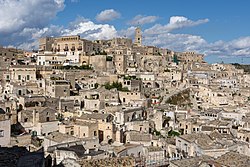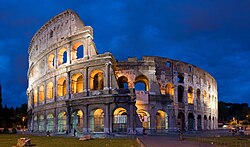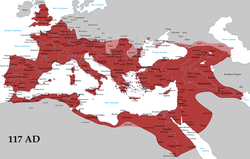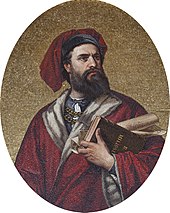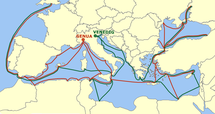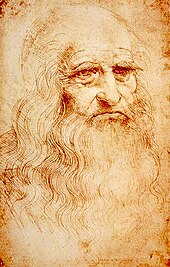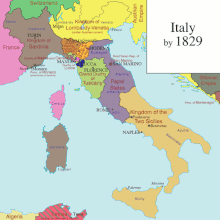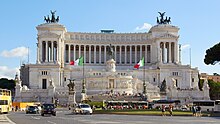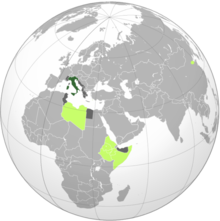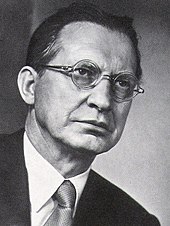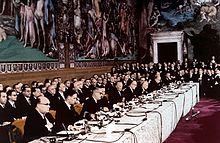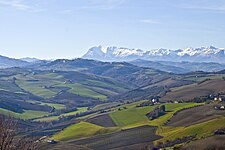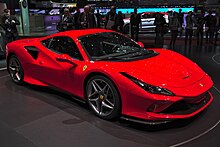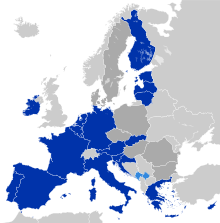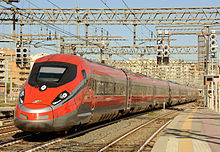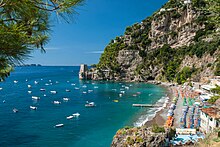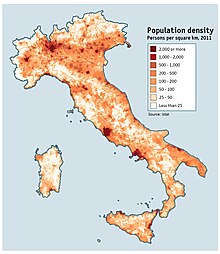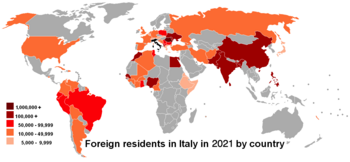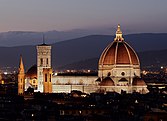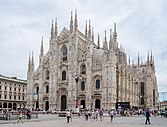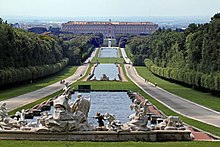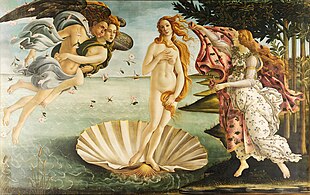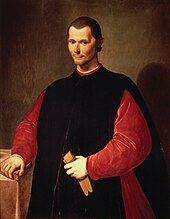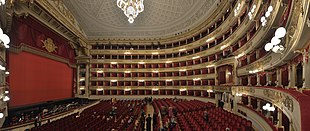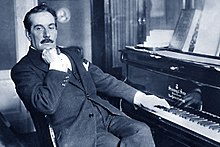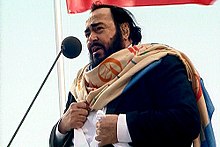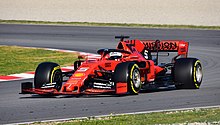Italy
|
Italian Republic
Repubblica Italiana (Italian)
|
|
|---|---|
| Anthem: Il Canto degli Italiani (Italian) “The Song of the Italians” |
|
|
Location of Italy (dark green)– in Europe (light green & dark grey)
– in the European Union (light green) – [Legend] |
|
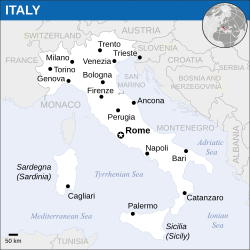 |
|
| Capital
and largest city
|
Rome 41°54′N 12°29′E |
| Official languages | Italiana |
| Native languages | see full list |
| Ethnic groups
(2017)[1]
|
|
| Religion
(2017)[2]
|
|
| Demonym(s) | Italian |
| Government | Unitary parliamentary republic |
| Sergio Mattarella | |
| Giuseppe Conte | |
| Elisabetta Casellati | |
| Roberto Fico | |
| Legislature | Parliament |
| Senate of the Republic | |
| Chamber of Deputies | |
| Formation | |
| 272 BC | |
| 17 March 1861 | |
|
• Republic
|
2 June 1946 |
| 1 January 1948 | |
| 1 January 1958 | |
| Area | |
|
• Total
|
301,340 km2 (116,350 sq mi) (71st) |
|
• Water (%)
|
2.4 |
| Population | |
|
• 2018 estimate
|
|
|
• 2011 census
|
|
|
• Density
|
201.3/km2 (521.4/sq mi) (63rd) |
| GDP (PPP) | 2019 estimate |
|
• Total
|
|
|
• Per capita
|
|
| GDP (nominal) | 2019 estimate |
|
• Total
|
|
|
• Per capita
|
|
| Gini (2018) | medium |
| HDI (2017) | very high · 28th |
| Currency | Euro (€)b (EUR) |
| Time zone | UTC+1 (CET) |
|
• Summer (DST)
|
UTC+2 (CEST) |
| Date format | dd/mm/yyyy yyyy–mm–dd (AD)[8] |
| Driving side | right |
| Calling code | +39c |
| ISO 3166 code | IT |
| Internet TLD | .itd |
|
|
Italy (Italian: Italia [iˈtaːlja] (![]() listen)), officially the Italian Republic (Italian: Repubblica Italiana [reˈpubblika itaˈljaːna]),[11][12][13][14] is a European country consisting of a peninsula delimited by the Alps and surrounded by several islands. Italy is located in Southern Europe,[15] and it is sometimes considered as part of Western Europe.[16][17] The country covers a total area of 301,340 km2 (116,350 sq mi) and shares land borders with France, Switzerland, Austria, Slovenia, and the enclaved microstates of Vatican City and San Marino. Italy has a territorial exclave in Switzerland (Campione) and a maritime exclave in the Tunisian Sea (Lampedusa). With around 60 million inhabitants, Italy is the fourth-most populous member state of the European Union.
listen)), officially the Italian Republic (Italian: Repubblica Italiana [reˈpubblika itaˈljaːna]),[11][12][13][14] is a European country consisting of a peninsula delimited by the Alps and surrounded by several islands. Italy is located in Southern Europe,[15] and it is sometimes considered as part of Western Europe.[16][17] The country covers a total area of 301,340 km2 (116,350 sq mi) and shares land borders with France, Switzerland, Austria, Slovenia, and the enclaved microstates of Vatican City and San Marino. Italy has a territorial exclave in Switzerland (Campione) and a maritime exclave in the Tunisian Sea (Lampedusa). With around 60 million inhabitants, Italy is the fourth-most populous member state of the European Union.
Due to its central geographic location in Southern Europe and the Mediterranean, Italy has historically been home to myriad peoples and cultures. In addition to the various ancient peoples dispersed throughout modern-day Italy, the most predominant being the Indo-European Italic peoples who gave the peninsula its name, beginning from the classical era, Phoenicians and Carthaginians founded colonies mostly in insular Italy,[18] Greeks established settlements in the so-called Magna Graecia of Southern Italy, while Etruscans and Celts inhabited central and northern Italy respectively. An Italic tribe known as the Latins formed the Roman Kingdom in the 8th century BC, which eventually became a republic with a government of the Senate and the People. The Roman Republic initially conquered and assimilated its neighbours on the peninsula, eventually expanding and conquering parts of Europe, North Africa and Asia. By the first century BC, the Roman Empire emerged as the dominant power in the Mediterranean Basin and became a leading cultural, political and religious centre, inaugurating the Pax Romana, a period of more than 200 years during which Italy’s law, technology, economy, art, and literature developed.[19][20] Italy remained the homeland of the Romans and the metropole of the empire, whose legacy can also be observed in the global distribution of culture, governments, Christianity and the Latin script.
During the Early Middle Ages, Italy endured sociopolitical collapse and barbarian invasions, but by the 11th century, numerous rival city-states and maritime republics, mainly in the northern and central regions of Italy, rose to great prosperity through trade, commerce and banking, laying the groundwork for modern capitalism.[21] These mostly independent statelets served as Europe’s main trading hubs with Asia and the Near East, often enjoying a greater degree of democracy than the larger feudal monarchies that were consolidating throughout Europe; however, part of central Italy was under the control of the theocratic Papal States, while Southern Italy remained largely feudal until the 19th century, partially as a result of a succession of Byzantine, Arab, Norman, Angevin, Aragonese and other foreign conquests of the region.[22] The Renaissance began in Italy and spread to the rest of Europe, bringing a renewed interest in humanism, science, exploration and art. Italian culture flourished, producing famous scholars, artists and polymaths. During the Middle Ages, Italian explorers discovered new routes to the Far East and the New World, helping to usher in the European Age of Discovery. Nevertheless, Italy’s commercial and political power significantly waned with the opening of trade routes that bypassed the Mediterranean.[23] Furthermore, centuries of infighting between the Italian city-states, such as the Italian Wars of the 15th and 16th centuries, left the region fragmented, and it was subsequently conquered, exploited, and further divided by European powers such as France, Spain and Austria.
By the mid-19th century, rising Italian nationalism and calls for independence from foreign control led to a period of revolutionary political upheaval. After centuries of foreign domination and political division, Italy was almost entirely unified in 1861, establishing the Kingdom of Italy as a great power.[24] From the late 19th century to the early 20th century, Italy rapidly industrialised, namely in the north, and acquired a colonial empire,[25] while the south remained largely impoverished and excluded from industrialisation, fuelling a large and influential diaspora.[26] Despite being one of the main victors in World War I, Italy entered a period of economic crisis and social turmoil, leading to the rise of a fascist dictatorship in 1922. Participation in World War II on the Axis side ended in military defeat, economic destruction and the Italian Civil War. Following the liberation of Italy and the rise of the resistance, the country abolished the monarchy, established a democratic Republic, and enjoyed a prolonged economic boom, becoming a highly developed country.[27]
Today, Italy is considered to be one of the world’s most culturally and economically advanced countries,[27][28][29] with its economy ranking eighth-largest in the world and third in the Eurozone by nominal GDP. Italy has the sixth-largest worldwide national wealth, the third-largest central bank gold reserve, and a very high life expectancy. The country plays a prominent role in regional and global economic, military, cultural and diplomatic affairs; it is both a regional power[30][31] and a great power,[32][33] and is ranked the world’s eighth most-powerful military. Italy is a founding and leading member of the European Union and a member of numerous international institutions, including the UN, NATO, the OECD, the OSCE, the WTO, the G7, the G20, the Union for the Mediterranean, the Council of Europe, Uniting for Consensus, the Schengen Area and many more. The country have greatly influenced and contributed to diverse fields, notably the arts, music, literature, philosophy, science and technology, fashion, cinema, cuisine, sports, as well as jurisprudence, banking and business.[34] As a reflection of its cultural wealth, Italy is home to the world’s largest number of World Heritage Sites (55), and is the fifth-most visited country.
Etymology
Expansion of the territory known as Italy and the nearby islands from the establishment of the Roman Republic until Diocletian.
Hypotheses for the etymology of the name “Italia” are numerous. One is that it was borrowed via Greek from the Oscan Víteliú ‘land of calves’ (cf. Lat vitulus “calf”, Umb vitlo “calf”).[36] The bull was a symbol of the southern Italic tribes and was often depicted goring the Roman wolf as a defiant symbol of free Italy during the Social War. Greek historian Dionysius of Halicarnassus states this account together with the legend that Italy was named after Italus, mentioned also by Aristotle[38] and Thucydides.
The name Italia originally applied only to a part of what is now Southern Italy, according to Antiochus of Syracuse, the southern portion of the Bruttium peninsula corresponding to the modern province of Reggio, and part of the provinces of Catanzaro and Vibo Valentia. But by his time Oenotria and Italy had become synonymous, and the name also applied to most of Lucania as well. The Greeks gradually came to apply the name “Italia” to a larger region, but the Peninsula and its borders expanded over time.[40]
According to Strabo‘s Geographica, before the expansion of the Roman Republic, the name was used by Greeks to indicate the land between the strait of Messina and the line connecting the gulf of Salerno and gulf of Taranto, corresponding roughly to the current region of Calabria. Later the term was extended by Romans to include the Italian Peninsula up to the Rubicon, a river located between Northern and Central Italy. In 49 BC, with the Lex Roscia, Julius Caesar gave Roman citizenship to the people of the Cisalpine Gaul, and then in 42 BC the hitherto existing province was abolished, thus extending Italy to the north up to the southern foot of the Alps.
It was during the reign of Emperor Augustus that the term was expanded to cover the entire peninsula until the Alps.[43] The islands of Sardinia, Corsica, Sicily and Malta were added to Italy by Diocletian in 292 AD.
History
Prehistory and antiquity
Thousands of Palaeolithic-era artifacts have been recovered from Monte Poggiolo and dated to around 850,000 years before the present, making them the oldest evidence of first hominins habitation in the peninsula. Excavations throughout Italy revealed a Neanderthal presence dating back to the Palaeolithic period some 200,000 years ago, while modern Humans appeared about 40,000 years ago at Riparo Mochi. Archaeological sites from this period include Addaura cave, Altamura, Ceprano, and Gravina in Puglia.
The Ancient peoples of pre-Roman Italy – such as the Umbrians, the Latins (from which the Romans emerged), Volsci, Oscans, Samnites, Sabines, the Celts, the Ligures, the Veneti and many others – were Indo-European peoples, most of them specifically of the Italic group. The main historic peoples of possible non-Indo-European or pre-Indo-European heritage include the Etruscans of central and northern Italy, the Elymians and the Sicani in Sicily, and the prehistoric Sardinians, who gave birth to the Nuragic civilisation. Other ancient populations being of undetermined language families and of possible non-Indo-European origin include the Rhaetian people and Cammuni, known for their rock carvings in Valcamonica, the largest collections of prehistoric petroglyphs in the world. A well-preserved natural mummy known as Ötzi the Iceman, determined to be 5,000 years old (between 3400 and 3100 BCE, Copper Age), was discovered in the Similaun glacier of South Tyrol in 1991.
The first foreign colonizers were the Phoenicians, who initially established colonies and founded various emporiums on the coasts of Sicily and Sardinia. Some of these soon became small urban centres and were developed parallel to the Greek colonies; among the main centres there were the cities of Motya, Zyz (modern Palermo), Soluntum in Sicily and Nora, Sulci, and Tharros in Sardinia.
Between the 17th and the 11th centuries BC Mycenaean Greeks established contacts with Italy[53][54][55][56] and in the 8th and 7th centuries BC a number of Greek colonies were established all along the coast of Sicily and the southern part of the Italian Peninsula, that became known as Magna Graecia. The Greek colonization placed the Italic peoples in contact with democratic government forms and with elevated artistic and cultural expressions.[57]
Ancient Rome
Rome, a settlement around a ford on the river Tiber in central Italy conventionally founded in 753 BC, was ruled for a period of 244 years by a monarchical system, initially with sovereigns of Latin and Sabine origin, later by Etruscan kings. The tradition handed down seven kings: Romulus, Numa Pompilius, Tullus Hostilius, Ancus Marcius, Tarquinius Priscus, Servius Tullius and Tarquinius Superbus. In 509 BC, the Romans expelled the last king from their city, favouring a government of the Senate and the People (SPQR) and establishing an oligarchic republic.
The Italian Peninsula, named Italia, was consolidated into a single entity during the Roman expansion and conquest of new lands at the expense of the other Italic tribes, Etruscans, Celts, and Greeks. A permanent association with most of the local tribes and cities was formed, and Rome began the conquest of Western Europe, Northern Africa and the Middle East. In the wake of Julius Caesar‘s rise and death in the first century BC, Rome grew over the course of centuries into a massive empire stretching from Britain to the borders of Persia, and engulfing the whole Mediterranean basin, in which Greek and Roman and many other cultures merged into a unique civilisation. The long and triumphant reign of the first emperor, Augustus, began a golden age of peace and prosperity. Italy remained the metropole of the empire, and as the homeland of the Romans and the territory of the capital, maintained a special status which made it “not a province, but the Domina (ruler) of the provinces“. More than two centuries of stability followed, during which Italy was referred to as the rectrix mundi (queen of the world) and omnium terrarum parens (motherland of all lands).
The Roman Empire was among the most powerful economic, cultural, political and military forces in the world of its time, and it was one of the largest empires in world history. At its height under Trajan, it covered 5 million square kilometres.[60][61] The Roman legacy has deeply influenced the Western civilisation, shaping most of the modern world; among the many legacies of Roman dominance are the widespread use of the Romance languages derived from Latin, the numerical system, the modern Western alphabet and calendar, and the emergence of Christianity as a major world religion.[62] The Indo-Roman trade relations, beginning around the 1st century BCE, testifies to extensive Roman trade in far away regions; many reminders of the commercial trade between the Indian subcontinent and Italy have been found, such as the ivory statuette Pompeii Lakshmi from the ruins of Pompeii.
In a slow decline since the third century AD, the Empire split in two in 395 AD. The Western Empire, under the pressure of the barbarian invasions, eventually dissolved in 476 AD when its last emperor, Romulus Augustulus, was deposed by the Germanic chief Odoacer. The Eastern half of the Empire survived for another thousand years.
Middle Ages
The Iron Crown of Lombardy, for centuries symbol of the Kings of Italy.
After the fall of the Western Roman Empire, Italy fell under the power of Odoacer’s kingdom, and, later, was seized by the Ostrogoths,[63] followed in the 6th century by a brief reconquest under Byzantine Emperor Justinian. The invasion of another Germanic tribe, the Lombards, late in the same century, reduced the Byzantine presence to the rump realm of the Exarchate of Ravenna and started the end of political unity of the peninsula for the next 1,300 years. Invasions of the peninsula caused a chaotic succession of barbarian kingdoms and the so-called “dark ages“. The Lombard kingdom was subsequently absorbed into the Frankish Empire by Charlemagne in the late 8th century. The Franks also helped the formation of the Papal States in central Italy. Until the 13th century, Italian politics was dominated by the relations between the Holy Roman Emperors and the Papacy, with most of the Italian city-states siding with the former (Ghibellines) or with the latter (Guelphs) from momentary convenience.
Marco Polo, explorer of the 13th century, recorded his 24 years-long travels in the Book of the Marvels of the World, introducing Europeans to Central Asia and China.
The Germanic Emperor and the Roman Pontiff became the universal powers of medieval Europe. However, the conflict for the investiture controversy (a conflict over two radically different views of whether secular authorities such as kings, counts, or dukes, had any legitimate role in appointments to ecclesiastical offices) and the clash between Guelphs and Ghibellines led to the end of the Imperial-feudal system in the north of Italy where city-states gained independence. It was during this chaotic era that Italian towns saw the rise of a peculiar institution, the medieval commune. Given the power vacuum caused by extreme territorial fragmentation and the struggle between the Empire and the Holy See, local communities sought autonomous ways to maintain law and order.[66] The investiture controversy was finally resolved by the Concordat of Worms. In 1176 a league of city-states, the Lombard League, defeated the German emperor Frederick Barbarossa at the Battle of Legnano, thus ensuring effective independence for most of northern and central Italian cities.
A 14th century conflict between Guelph and Ghibelline factions as portrayed in the Nuova Cronica by Giovanni Villani.
Italian city-states such as Milan, Florence and Venice played a crucial innovative role in financial development, devising the main instruments and practices of banking and the emergence of new forms of social and economic organization. In coastal and southern areas, the maritime republics grew to eventually dominate the Mediterranean and monopolise trade routes to the Orient. They were independent thalassocratic city-states, though most of them originated from territories once belonging to the Byzantine Empire. All these cities during the time of their independence had similar systems of government in which the merchant class had considerable power. Although in practice these were oligarchical, and bore little resemblance to a modern democracy, the relative political freedom they afforded was conducive to academic and artistic advancement. The four most prominent maritime republics were Venice, Genoa, Pisa and Amalfi; the others were Ancona, Gaeta, Noli, and Ragusa. Each of the maritime republics had dominion over different overseas lands, including many Mediterranean islands (especially Sardinia and Corsica), lands on the Adriatic, Aegean, and Black Sea (Crimea), and commercial colonies in the Near East and in North Africa. Venice maintained enormous tracts of land in Greece, Cyprus, Istria and Dalmatia until as late as the mid-17th century.
Right: trade routes and colonies of the Genoese (red) and Venetian (green) empires.
Venice and Genoa were Europe’s main gateway to trade with the East, and a producer of fine glass, while Florence was a capital of silk, wool, banks and jewellery. The wealth such business brought to Italy meant that large public and private artistic projects could be commissioned. The republics were heavily involved in the Crusades, providing support and transport, but most especially taking advantage of the political and trading opportunities resulting from these wars. Italy first felt huge economic changes in Europe which led to the commercial revolution: the Republic of Venice was able to defeat the Byzantine Empire and finance the voyages of Marco Polo to Asia; the first universities were formed in Italian cities, and scholars such as Thomas Aquinas obtained international fame; Frederick of Sicily made Italy the political-cultural centre of a reign that temporarily included the Holy Roman Empire and the Kingdom of Jerusalem; capitalism and banking families emerged in Florence, where Dante and Giotto were active around 1300.
In the south, Sicily had become an Islamic emirate in the 9th century, thriving until the Italo-Normans conquered it in the late 11th century together with most of the Lombard and Byzantine principalities of southern Italy.[73] Through a complex series of events, southern Italy developed as a unified kingdom, first under the House of Hohenstaufen, then under the Capetian House of Anjou and, from the 15th century, the House of Aragon. In Sardinia, the former Byzantine provinces became independent states known in Italian as Judicates, although some parts of the island fell under Genoese or Pisan rule until the eventual Aragonese annexation in the 15th century. The Black Death pandemic of 1348 left its mark on Italy by killing perhaps one third of the population.[74][75] However, the recovery from the plague led to a resurgence of cities, trade and economy which allowed the bloom of Humanism and Renaissance, that later spread to Europe.
Early Modern
Italian states before the beginning of the Italian Wars in 1494.
Italy was the birthplace and heart of the Renaissance during the 1400s and 1500s. The Italian Renaissance marked the transition from the medieval period to the modern age as Europe recovered, economically and culturally, from the crises of the Late Middle Ages and entered the Early Modern Period. The Italian polities were now regional states effectively ruled by Princes, de facto monarchs in control of trade and administration, and their courts became major centres of Arts and Sciences. The Italian princedoms represented a first form of modern states as opposed to feudal monarchies and multinational empires. The princedoms were led by political dynasties and merchant families such as the Medici in Florence, the Visconti and Sforza in the Duchy of Milan, the Doria in the Republic of Genoa, the Mocenigo and Barbarigo in the Republic of Venice, the Este in Ferrara, and the Gonzaga in Mantua.[76][77] The Renaissance was therefore a result of the great wealth accumulated by Italian merchant cities combined with the patronage of its dominant families.[76] Italian Renaissance exercised a dominant influence on subsequent European painting and sculpture for centuries afterwards, with artists such as Leonardo da Vinci, Brunelleschi, Botticelli, Michelangelo, Raphael, Giotto, Donatello, and Titian, and architects such as Filippo Brunelleschi, Leon Battista Alberti, Andrea Palladio, and Donato Bramante.
Leonardo da Vinci, the quintessential Renaissance man, in a self-portrait, c. 1512. Royal Library, Turin.
Following the conclusion of the western schism in favor of Rome at the Council of Constance (1415–1417), the new Pope Martin V returned to the Papal States after a three years-long journey that touched many Italian cities and restored Italy as the sole centre of Western Christianity. During the course of this voyage, the Medici Bank was made the official credit institution of the Papacy and several significant ties were established between the Church and the new political dynasties of the peninsula. The Popes’ status as elective monarchs turned the conclaves and consistories of the Renaissance into political battles between the courts of Italy for primacy in the peninsula and access to the immense resources of the Catholic Church. In 1439, Pope Eugenius IV and the Byzantine Emperor John VIII Palaiologos signed a reconciliation agreement between the Catholic Church and the Orthodox Church at the Council of Florence hosted by Cosimo the old de Medici. In 1453, Italian forces under Giovanni Giustiniani were sent by Pope Nicholas V to defend the Walls of Constantinople but the decisive battle was lost to the more advanced Turkish army equipped with cannons, and Byzantium fell to Sultan Mehmed II.
The fall of Constantinople led to the migration of Greek scholars and texts to Italy, fueling the rediscovery of Greco-Roman Humanism.[78][79][80] Humanist rulers such as Federico da Montefeltro and Pope Pius II worked to establish ideal cities where man is the measure of all things, and therefore founded Urbino and Pienza respectively. Pico della Mirandola wrote the Oration on the Dignity of Man, considered the manifesto of Renaissance Humanism, in which he stressed the importance of free will in human beings. The humanist historian Leonardo Bruni was the first to divide human history in three periods: Antiquity, Middle Ages and Modernity. The second consequence of the Fall of Constantinople was the beginning of the Age of Discovery.
Christopher Columbus leads an expedition to the New World, 1492. His voyages are celebrated as the discovery of the Americas from a European perspective, and they opened a new era in the history of humankind and sustained contact between the two worlds.
Italian explorers and navigators from the dominant maritime republics, eager to find an alternative route to the Indies in order to bypass the Ottoman Empire, offered their services to monarchs of Atlantic countries and played a key role in ushering the Age of Discovery and the European colonization of the Americas. The most notable among them were: Christopher Columbus, colonizer in the name of Spain, who is credited with discovering the New World and the opening of the Americas for conquest and settlement by Europeans; John Cabot, sailing for England, who was the first European to set foot in “New Found Land” and explore parts of the North American continent in 1497; Amerigo Vespucci, sailing for Portugal, who first demonstrated in about 1501 that the New World (in particular Brazil) was not Asia as initially conjectured, but a fourth continent previously unknown to people of the Old World (America is named after him); and Giovanni da Verrazzano, at the service of France, renowned as the first European to explore the Atlantic coast of North America between Florida and New Brunswick in 1524;
Following the fall of Constantinople, the wars in Lombardy came to an end and a defensive alliance known as Italic League was formed between Venice, Naples, Florence, Milan, and the Papacy. Lorenzo the Magnificent de Medici was the greatest Florentine patron of the Renaissance and supporter of the Italic League. He notably avoided the collapse of the League in the aftermath of the Pazzi Conspiracy and during the aborted invasion of Italy by the Turks. However, the military campaign of Charles VIII of France in Italy caused the end of the Italic League and initiated the Italian Wars between the Valois and the Habsburgs. During the High Renaissance of the 1500s, Italy was therefore both the main European battleground and the cultural-economic centre of the continent. Popes such as Julius II (1503–1513) fought for the control of Italy against foreign monarchs, others such as Paul III (1534–1549) preferred to mediate between the European powers in order to secure peace in Italy. In the middle of this conflict, the Medici popes Leo X (1513–1521) and Clement VII (1523–1534) opposed the Protestant reformation and advanced the interests of their family. The end of the wars ultimately left northern Italy indirectly subject to the Austrian Habsburgs and Southern Italy under direct Spanish Habsburg rule.
The Papacy remained independent and launched the Counter-reformation. Key events of the period include: the Council of Trent (1545–1563); the excommunication of Elizabeth I (1570) and the Battle of Lepanto (1571), both occurring during the pontificate of Pius V; the construction of the Gregorian observatory, the adoption of the Gregorian calendar, and the Jesuit China mission of Matteo Ricci under Pope Gregory XIII; the French Wars of Religion; the Long Turkish War and the execution of Giordano Bruno in 1600, under Pope Clement VIII; the birth of the Lyncean Academy of the Papal States, of which the main figure was Galileo Galilei (later put on trial); the final phases of the Thirty Years’ War (1618–1648) during the pontificates of Urban VIII and Innocent X; and the formation of the last Holy League by Innocent XI during the Great Turkish War
The Italian economy declined during the 1600s and 1700s, as the peninsula was excluded from the rising Atlantic slave trade. Following the European wars of succession of the 18th century, the south passed to a cadet branch of the Spanish Bourbons and the North fell under the influence of the Habsburg-Lorraine of Austria. During the Coalition Wars, northern-central Italy was reorganised by Napoleon in a number of Sister Republics of France and later as a Kingdom of Italy in personal union with the French Empire.[87] The southern half of the peninsula was administered by Joachim Murat, Napoleon’s brother-in-law, who was crowned as King of Naples. The 1814 Congress of Vienna restored the situation of the late 18th century, but the ideals of the French Revolution could not be eradicated, and soon re-surfaced during the political upheavals that characterised the first part of the 19th century.
Italian unification
The birth of the Kingdom of Italy was the result of efforts by Italian nationalists and monarchists loyal to the House of Savoy to establish a united kingdom encompassing the entire Italian Peninsula. Following the Congress of Vienna in 1815, the political and social Italian unification movement, or Risorgimento, emerged to unite Italy consolidating the different states of the peninsula and liberate it from foreign control. A prominent radical figure was the patriotic journalist Giuseppe Mazzini, member of the secret revolutionary society Carbonari and founder of the influential political movement Young Italy in the early 1830s, who favoured a unitary republic and advocated a broad nationalist movement. His prolific output of propaganda helped the unification movement stay active.
The most famous member of Young Italy was the revolutionary and general Giuseppe Garibaldi, renowned for his extremely loyal followers,[90] who led the Italian republican drive for unification in Southern Italy. However, the Northern Italy monarchy of the House of Savoy in the Kingdom of Sardinia, whose government was led by Camillo Benso, Count of Cavour, also had ambitions of establishing a united Italian state. In the context of the 1848 liberal revolutions that swept through Europe, an unsuccessful first war of independence was declared on Austria. In 1855, the Kingdom of Sardinia became an ally of Britain and France in the Crimean War, giving Cavour’s diplomacy legitimacy in the eyes of the great powers. The Kingdom of Sardinia again attacked the Austrian Empire in the Second Italian War of Independence of 1859, with the aid of France, resulting in liberating Lombardy.
In 1860–1861, Garibaldi led the drive for unification in Naples and Sicily (the Expedition of the Thousand), while the House of Savoy troops occupied the central territories of the Italian peninsula, except Rome and part of Papal States. Teano was the site of the famous meeting of 26 October 1860 between Giuseppe Garibaldi and Victor Emmanuel II, last King of Sardinia, in which Garibaldi shook Victor Emanuel’s hand and hailed him as King of Italy; thus, Garibaldi sacrificed republican hopes for the sake of Italian unity under a monarchy. Cavour agreed to include Garibaldi’s Southern Italy allowing it to join the union with the Kingdom of Sardinia in 1860. This allowed the Sardinian government to declare a united Italian kingdom on 17 March 1861.[94] Victor Emmanuel II then became the first king of a united Italy, and the capital was moved from Turin to Florence.
In 1866, Victor Emmanuel II allied with Prussia during the Austro-Prussian War, waging the Third Italian War of Independence which allowed Italy to annexe Venetia. Finally, in 1870, as France abandoned its garrisons in Rome during the disastrous Franco-Prussian War to keep the large Prussian Army at bay, the Italians rushed to fill the power gap by taking over the Papal States. Italian unification was completed and shortly afterward Italy’s capital was moved to Rome. Victor Emmanuel, Garibaldi, Cavour and Mazzini have been referred as Italy’s Four Fathers of the Fatherland.
Monarchical period
The new Kingdom of Italy obtained Great Power status. The Constitutional Law of the Kingdom of Sardinia the Albertine Statute of 1848, was extended to the whole Kingdom of Italy in 1861, and provided for basic freedoms of the new State, but electoral laws excluded the non-propertied and uneducated classes from voting. The government of the new kingdom took place in a framework of parliamentary constitutional monarchy dominated by liberal forces. As Northern Italy quickly industrialised, the South and rural areas of the North remained underdeveloped and overpopulated, forcing millions of people to migrate abroad and fuelling a large and influential diaspora. The Italian Socialist Party constantly increased in strength, challenging the traditional liberal and conservative establishment.
The Altare della Patria in Rome, national monument of Italy dedicated to King Victor Emmanuel II, holds the tomb of the Unknown Soldier since the end of World War I.
In 1913, male universal suffrage was adopted. The pre-war period dominated by Giovanni Giolitti, Prime Minister five times between 1892 and 1921, was characterized by the economic, industrial and political-cultural modernization of Italian society. Starting from the last two decades of the 19th century, Italy developed into a colonial power by forcing Somalia, Eritrea and later Libya and the Dodecanese under its rule.[95] From 2 November 1899 to 7 September 1901, Italy also participated as part of the Eight-Nation Alliance forces during the Boxer Rebellion in China; on 7 September 1901, a concession in Tientsin was ceded to the country, and on 7 June 1902, the concession was taken into Italian possession and administered by a consul.
Italy, nominally allied with the German Empire and the Empire of Austria-Hungary in the Triple Alliance, in 1915 joined the Allies into World War I with a promise of substantial territorial gains, that included western Inner Carniola, former Austrian Littoral, Dalmatia as well as parts of the Ottoman Empire. The country gave a fundamental contribution to the victory of the conflict as one of the “Big Four” top Allied powers. The war was initially inconclusive, as the Italian army got stuck in a long attrition war in the Alps, making little progress and suffering very heavy losses. However, the reorganization of the army and the conscription of the so-called ‘99 Boys (Ragazzi del ’99, all males born in 1899 who were turning 18) led to more effective Italian victories in major battles, such as on Monte Grappa and in a series of battles on the Piave river. Eventually, in October 1918, the Italians launched a massive offensive, culminating in the victory of Vittorio Veneto. The Italian victory[96][97][98] marked the end of the war on the Italian Front, secured the dissolution of the Austro-Hungarian Empire and was chiefly instrumental in ending the First World War less than two weeks later.
During the war, more than 650,000 Italian soldiers and as many civilians died[99] and the kingdom went to the brink of bankruptcy. Under the Peace Treaties of Saint-Germain, Rapallo and Rome, Italy gained a permanent seat in the League of Nations‘s executive council and obtained most of the promised territories, but not Dalmatia (except Zara), allowing nationalists to define the victory as “mutilated“. Moreover, Italy annexed the Hungarian harbour of Fiume, that was not part of territories promised at London but had been occupied after the end of the war by Gabriele D’Annunzio.
Fascist regime
The socialist agitations that followed the devastation of the Great War, inspired by the Russian Revolution, led to counter-revolution and repression throughout Italy. The liberal establishment, fearing a Soviet-style revolution, started to endorse the small National Fascist Party, led by Benito Mussolini. In October 1922 the Blackshirts of the National Fascist Party attempted a coup named the “March on Rome” which failed but at the last minute, King Victor Emmanuel III refused to proclaim a state of siege and appointed Mussolini prime minister. Over the next few years, Mussolini banned all political parties and curtailed personal liberties, thus forming a dictatorship. These actions attracted international attention and eventually inspired similar dictatorships such as Nazi Germany and Francoist Spain.
In 1935, Mussolini invaded Ethiopia and founded the Italian East Africa, resulting in an international alienation and leading to Italy’s withdrawal from the League of Nations; Italy allied with Nazi Germany and the Empire of Japan and strongly supported Francisco Franco in the Spanish civil war. In 1939, Italy annexed Albania, a de facto protectorate for decades. Italy entered World War II on 10 June 1940. After initially advancing in British Somaliland, Egypt, the Balkans and eastern fronts, the Italians were defeated in East Africa, Soviet Union and North Africa.
Map of the Italian colonial empire at its maximum extent, with colonies in light green and protectorates or occupied areas during WWII in grey.
The Armistice of Villa Giusti, which ended fighting between Italy and Austria-Hungary at the end of World War I, resulted in Italian annexation of neighbouring parts of Yugoslavia. During the interwar period, the fascist Italian government undertook a campaign of Italianisation in the areas it annexed, which suppressed Slavic language, schools, political parties, and cultural institutions. During World War II, Italian war crimes included extrajudicial killings and ethnic cleansing[100] by deportation of about 25,000 people, mainly Jews, Croats, and Slovenians, to the Italian concentration camps, such as Rab, Gonars, Monigo, Renicci di Anghiari and elsewhere. In Italy and Yugoslavia, unlike in Germany, few war crimes were prosecuted.[101][102][103][104] Yugoslav Partisans perpetrated their own crimes during and after the war, including the foibe killings. Meanwhile, about 250,000 Italians and anti-communist Slavs fled to Italy in the Istrian exodus.
An Allied invasion of Sicily began in July 1943, leading to the collapse of the Fascist regime and the fall of Mussolini on 25 July. Mussolini was deposed and arrested by order of King Victor Emmanuel III in co-operation with the majority of the members of the Grand Council of Fascism, which passed a motion of no confidence. On 8 September, Italy signed the Armistice of Cassibile, ending its war with the Allies. The Germans helped by the Italian fascists shortly succeeded in taking control of northern and central Italy. The country remained a battlefield for the rest of the war, as the Allies were slowly moving up from the south.
In the north, the Germans set up the Italian Social Republic (RSI), a Nazi puppet state with Mussolini installed as leader after he was rescued by German paratroopers. Some Italian troops in the south were organized into the Italian Co-belligerent Army, which fought alongside the Allies for the rest of the war, while other Italian troops, loyal to Mussolini and his RSI, continued to fight alongside the Germans in the National Republican Army. As result, the country descended into civil war. Also, the post-armistice period saw the rise of a large anti-fascist resistance movement, the Resistenza, which fought a guerilla war against the German and RSI forces. In late April 1945, with total defeat looming, Mussolini attempted to escape north,[105] but was captured and summarily executed near Lake Como by Italian partisans. His body was then taken to Milan, where it was hung upside down at a service station for public viewing and to provide confirmation of his demise.[106] Hostilities ended on 29 April 1945, when the German forces in Italy surrendered. Nearly half a million Italians (including civilians) died in the conflict,[107] and the Italian economy had been all but destroyed; per capita income in 1944 was at its lowest point since the beginning of the 20th century.[108]
Republican Italy
Alcide De Gasperi, first republican Prime Minister of Italy and one of the Founding Fathers of the European Union
Italy became a republic after a referendum[109] held on 2 June 1946, a day celebrated since as Republic Day. This was also the first time that Italian women were entitled to vote.[110] Victor Emmanuel III‘s son, Umberto II, was forced to abdicate and exiled. The Republican Constitution was approved on 1 January 1948. Under the Treaty of Peace with Italy of 1947, most of Julian March was lost to Yugoslavia and, later, the Free Territory of Trieste was divided between the two states. Italy also lost all of its colonial possessions, formally ending the Italian Empire. In 1950, Italian Somaliland was made a United Nations Trust Territory under Italian administration until 1 July 1960.
Fears of a possible Communist takeover (especially in the United States) proved crucial for the first universal suffrage electoral outcome on 18 April 1948, when the Christian Democrats, under the leadership of Alcide De Gasperi, obtained a landslide victory.[111] Consequently, in 1949 Italy became a member of NATO. The Marshall Plan helped to revive the Italian economy which, until the late 1960s, enjoyed a period of sustained economic growth commonly called the “Economic Miracle“. In 1957, Italy was a founding member of the European Economic Community (EEC), which became the European Union (EU) in 1993.
The signing ceremony of the Treaty of Rome on 25 March 1957, creating the European Economic Community, forerunner of the present-day European Union. Italy is a founding member of all EU institutions.
From the late 1960s until the early 1980s, the country experienced the Years of Lead, a period characterised by economic crisis (especially after the 1973 oil crisis), widespread social conflicts and terrorist massacres carried out by opposing extremist groups, with the alleged involvement of US and Soviet intelligence.[112][113][114] The Years of Lead culminated in the assassination of the Christian Democrat leader Aldo Moro in 1978 and the Bologna railway station massacre in 1980, where 85 people died.
In the 1980s, for the first time since 1945, two governments were led by non-Christian-Democrat premiers: one republican (Giovanni Spadolini) and one socialist (Bettino Craxi); the Christian Democrats remained, however, the main government party. During Craxi’s government, the economy recovered and Italy became the world’s fifth largest industrial nation, after it gained the entry into the G7 Group in ’70s. However, as a result of his spending policies, the Italian national debt skyrocketed during the Craxi era, soon passing 100% of the country’s GDP.
Italy faced several terror attacks between 1992–93 perpetrated by the Sicilian Mafia as a consequence of several life sentences pronounced during the “Maxi Trial“, and of the new anti-mafia measures launched by the government. In 1992, two major dynamite attacks killed the judges Giovanni Falcone (23 May in the Capaci bombing) and Paolo Borsellino (19 July in the Via D’Amelio bombing).[115] One year later (May–July 1993), tourist spots were attacked, such as the Via dei Georgofili in Florence, Via Palestro in Milan, and the Piazza San Giovanni in Laterano and Via San Teodoro in Rome, leaving 10 dead and 93 injured and causing severe damage to cultural heritage such as the Uffizi Gallery. The Catholic Church openly condemned the Mafia, and two churches were bombed and an anti-Mafia priest shot dead in Rome.[116][117][118] Also in the early 1990s, Italy faced significant challenges, as voters – disenchanted with political paralysis, massive public debt and the extensive corruption system (known as Tangentopoli) uncovered by the Clean Hands (Mani Pulite) investigation – demanded radical reforms. The scandals involved all major parties, but especially those in the government coalition: the Christian Democrats, who ruled for almost 50 years, underwent a severe crisis and eventually disbanded, splitting up into several factions.[119] The Communists reorganised as a social-democratic force. During the 1990s and the 2000s, centre-right (dominated by media magnate Silvio Berlusconi) and centre-left coalitions (led by university professor Romano Prodi) alternately governed the country.
In the late 2000s, Italy was severely hit by the Great Recession. From 2008 to 2013, the country suffered 42 months of GDP recession. The economic crisis was one of the main problems that forced Berlusconi to resign in 2011. The government of the conservative Prime Minister was replaced by the technocratic cabinet of Mario Monti. Following the 2013 general election, the Vice-Secretary of the Democratic Party Enrico Letta formed a new government at the head of a right-left Grand coalition. In 2014, challenged by the new Secretary of the PD Matteo Renzi, Letta resigned and was replaced by Renzi. The new government started important constitutional reforms such as the abolition of the Senate and a new electoral law. On 4 December the constitutional reform was rejected in a referendum and Renzi resigned after few days on 12 December; the Foreign Affairs Minister Paolo Gentiloni was appointed new Prime Minister.
Italy was affected by the European migrant crisis in 2015 as it became the entry point and leading destination for most asylum seekers entering the EU. Since 2013, the country took in over 700,000 migrants and refugees,[120] mainly from sub-Saharan Africa,[121] which caused great strain on the public purse and a surge in the support for far-right, euroskeptic or eurocritical political parties,[122][123] which ended in the 2018 general election. The election was characterized by a strong showing of the Five Star Movement and the League and the university professor Giuseppe Conte became the Prime Minister at the head of a populist coalition between these two parties.[124] However, after only fourteen months the League withdrew its support to Conte, who formed a new unprecedented government coalition between the Five Star Movement and the centre-left.[125][126]
Geography
Italy is located in Southern Europe, between latitudes 35° and 47° N, and longitudes 6° and 19° E. To the north, Italy borders France, Switzerland, Austria, and Slovenia and is roughly delimited by the Alpine watershed, enclosing the Po Valley and the Venetian Plain. To the south, it consists of the entirety of the Italian Peninsula and the two Mediterranean islands of Sicily and Sardinia (the two biggest islands of the Mediterranean), in addition to many smaller islands. The sovereign states of San Marino and the Vatican City are enclaves within Italy,[127][128] while Campione d’Italia is an Italian exclave in Switzerland.[129]
The country’s total area is 301,230 square kilometres (116,306 sq mi), of which 294,020 km2 (113,522 sq mi) is land and 7,210 km2 (2,784 sq mi) is water.[130] Including the islands, Italy has a coastline and border of 7,600 kilometres (4,722 miles) on the Adriatic, Ionian, Tyrrhenian seas (740 km (460 mi)), and borders shared with France (488 km (303 mi)), Austria (430 km (267 mi)), Slovenia (232 km (144 mi)) and Switzerland (740 km (460 mi)). San Marino (39 km (24 mi)) and Vatican City (3.2 km (2.0 mi)), both enclaves, account for the remainder.[130]
The Apennine Mountains form the peninsula’s backbone, and the Alps form most of its northern boundary, where Italy’s highest point is located on Monte Bianco (4,810 m or 15,780 ft).[note 1] The Po, Italy’s longest river (652 kilometres or 405 miles), flows from the Alps on the western border with France and crosses the Padan plain on its way to the Adriatic Sea. The five largest lakes are, in order of diminishing size:[131] Garda (367.94 km2 or 142 sq mi), Maggiore (212.51 km2 or 82 sq mi, whose minor northern part is Switzerland), Como (145.9 km2 or 56 sq mi), Trasimeno (124.29 km2 or 48 sq mi) and Bolsena (113.55 km2 or 44 sq mi).
Although the country includes the Italian peninsula, adjacent islands, and most of the southern Alpine basin, some of Italy’s territory extends beyond the Alpine basin and some islands are located outside the Eurasian continental shelf. These territories are the comuni of: Livigno, Sexten, Innichen, Toblach (in part), Chiusaforte, Tarvisio, Graun im Vinschgau (in part), which are all part of the Danube’s drainage basin, while the Val di Lei constitutes part of the Rhine‘s basin and the islands of Lampedusa and Lampione are on the African continental shelf.
The Three Peaks of Lavaredo in the Dolomites, a UNESCO World Heritage Site
Waters
Four different seas surround the Italian Peninsula in the Mediterranean Sea from three sides: the Adriatic Sea in the east,[132] the Ionian Sea in the south,[133] and the Ligurian Sea and the Tyrrhenian Sea in the west.[134]
Most of the rivers of Italy drain either into the Adriatic Sea, such as the Po, Piave, Adige, Brenta, Tagliamento, and Reno, or into the Tyrrhenian, like the Arno, Tiber and Volturno. The waters from some border municipalities (Livigno in Lombardy, Innichen and Sexten in Trentino-Alto Adige/Südtirol) drain into the Black Sea through the basin of the Drava, a tributary of the Danube, and the waters from the Lago di Lei in Lombardy drain into the North Sea through the basin of the Rhine.[135]
In the north of the country are a number of subalpine moraine-dammed lakes, the largest of which is Garda (370 km2 or 143 sq mi). Other well-known subalpine lakes are Lake Maggiore (212.5 km2 or 82 sq mi), whose most northerly section is part of Switzerland, Como (146 km2 or 56 sq mi), one of the deepest lakes in Europe, Orta, Lugano, Iseo, and Idro.[136] Other notable lakes in the Italian peninsula are Trasimeno, Bolsena, Bracciano, Vico, Varano and Lesina in Gargano and Omodeo in Sardinia.[137]
Volcanology
Mount Etna is an active stratovolcano in Sicily.
View of Naples with Mount Vesuvius.
The country is situated at the meeting point of the Eurasian Plate and the African Plate, leading to considerable seismic and volcanic activity. There are 14 volcanoes in Italy, four of which are active: Etna, Stromboli, Vulcano and Vesuvius. The last is the only active volcano in mainland Europe and is most famous for the destruction of Pompeii and Herculanum in the eruption in 79 AD. Several islands and hills have been created by volcanic activity, and there is still a large active caldera, the Campi Flegrei north-west of Naples.
The high volcanic and magmatic neogenic activity is subdivided into provinces:
- Magmatic Tuscan (Monti Cimini, Tolfa and Amiata);[138][139]
- Magmatic Latium (Monti Volsini, Vico nel Lazio, Colli Albani, Roccamonfina);[139][140]
- Ultra-alkaline Umbrian Latium District (San Venanzo, Cupaello and Polino);[139][140]
- Volcanic bell (Vesuvius, Campi Flegrei, Ischia);[139][140]
- Windy arch and Tyrrhenian basin (Aeolian Islands and Tyrrhenian seamounts);[139][140]
- African-Adriatic Avampa (Channel of Sicily, Graham Island, Etna and Mount Vulture).[139][140]
Italy was the first country to exploit geothermal energy to produce electricity.[141] The high geothermal gradient that forms part of the peninsula makes potentially exploitable also other provinces: research carried out in the 1960s and 1970s identifies potential geothermal fields in Lazio and Tuscany, as well as in most volcanic islands.[141]
Environment
After its quick industrial growth, Italy took a long time to confront its environmental problems. After several improvements, it now ranks 84th in the world for ecological sustainability.[142] National parks cover about 5% of the country.[143] In the last decade, Italy has become one of the world’s leading producers of renewable energy, ranking as the world’s fourth largest holder of installed solar energy capacity[144][145] and the sixth largest holder of wind power capacity in 2010.[146] Renewable energies now make up about 12% of the total primary and final energy consumption in Italy, with a future target share set at 17% for the year 2020.[147] However, air pollution remains a severe problem, especially in the industrialised north, reaching the tenth highest level worldwide of industrial carbon dioxide emissions in the 1990s.[148] Italy is the twelfth largest carbon dioxide producer.[149][150] Extensive traffic and congestion in the largest metropolitan areas continue to cause severe environmental and health issues, even if smog levels have decreased dramatically since the 1970s and 1980s, and the presence of smog is becoming an increasingly rarer phenomenon and levels of sulphur dioxide are decreasing.[151]
Gran Paradiso, established in 1922, is the oldest Italian national park
Many watercourses and coastal stretches have also been contaminated by industrial and agricultural activity, while because of rising water levels, Venice has been regularly flooded throughout recent years. Waste from industrial activity is not always disposed of by legal means and has led to permanent health effects on inhabitants of affected areas, as in the case of the Seveso disaster. The country has also operated several nuclear reactors between 1963 and 1990 but, after the Chernobyl disaster and a referendum on the issue the nuclear programme was terminated, a decision that was overturned by the government in 2008, planning to build up to four nuclear power plants with French technology. This was in turn struck down by a referendum following the Fukushima nuclear accident.[152]
Deforestation, illegal building developments and poor land-management policies have led to significant erosion all over Italy’s mountainous regions, leading to major ecological disasters like the 1963 Vajont Dam flood, the 1998 Sarno[153] and 2009 Messina mudslides.
Biodiversity
The Italian wolf, which inhabits the Apennines and Western Alps, features prominently in Latin and Italian cultures, such as in the legend of the founding of Rome.[154]
Italy has the highest level of faunal biodiversity in Europe, with over 57,000 species recorded, representing more than a third of all European fauna.[155] Italy’s varied geological structure contributes to its high climate and habitat diversity. The Italian peninsula is in the centre of the Mediterranean Sea, forming a corridor between central Europe and North Africa, and has 8,000 km (5,000 mi) of coastline. Italy also receives species from the Balkans, Eurasia, the Middle East. Italy’s varied geological structure, including the Alps and the Apennines, Central Italian woodlands, and Southern Italian Garigue and Maquis shrubland, also contributes to high climate and habitat diversity.
Italian fauna includes 4,777 endemic animal species, which include the Sardinian long-eared bat, Sardinian red deer, spectacled salamander, brown cave salamander, Italian newt, Italian frog, Apennine yellow-bellied toad, Aeolian wall lizard, Sicilian wall lizard, Italian Aesculapian snake, and Sicilian pond turtle. There are 102 mammals species (most notably the Italian wolf, Marsican brown bear, Pyrenean chamois, Alpine ibex, crested porcupine, Mediterranean monk seal, Alpine marmot, Etruscan shrew, and European snow vole), 516 bird species and 56,213 invertebrate species.
The flora of Italy was traditionally estimated to comprise about 5,500 vascular plant species.[156] However, as of 2005, 6,759 species are recorded in the Data bank of Italian vascular flora.[157] Italy is a signatory to the Berne Convention on the Conservation of European Wildlife and Natural Habitats and the Habitats Directive both affording protection to Italian fauna and flora.
Climate
Because of the great longitudinal extension of the peninsula and the mostly mountainous internal conformation, the climate of Italy is highly diverse. In most of the inland northern and central regions, the climate ranges from humid subtropical to humid continental and oceanic. In particular, the climate of the Po valley geographical region is mostly continental, with harsh winters and hot summers.[159][160]
The coastal areas of Liguria, Tuscany and most of the South generally fit the Mediterranean climate stereotype (Köppen climate classification Csa). Conditions on peninsular coastal areas can be very different from the interior’s higher ground and valleys, particularly during the winter months when the higher altitudes tend to be cold, wet, and often snowy. The coastal regions have mild winters and warm and generally dry summers, although lowland valleys can be quite hot in summer. Average winter temperatures vary from 0 °C (32 °F) on the Alps to 12 °C (54 °F) in Sicily, so average summer temperatures range from 20 °C (68 °F) to over 25 °C (77 °F). Winters can vary widely across the country with lingering cold, foggy and snowy periods in the north and milder, sunnier conditions in the south. Summers can be hot and humid across the country, particularly in the south while northern and central areas can experience occasional strong thunderstorms from spring to autumn.[161]
Politics
Italy has been a unitary parliamentary republic since 2 June 1946, when the monarchy was abolished by a constitutional referendum. The President of Italy (Presidente della Repubblica), currently Sergio Mattarella since 2015, is Italy’s head of state. The President is elected for a single seven years mandate by the Parliament of Italy and some regional voters in joint session. Italy has a written democratic constitution, resulting from the work of a Constituent Assembly formed by the representatives of all the anti-fascist forces that contributed to the defeat of Nazi and Fascist forces during the Civil War.[162]
Government
Italy has a parliamentary government based on a mixed proportional and majoritarian voting system. The parliament is perfectly bicameral: the two houses, the Chamber of Deputies that meets in Palazzo Montecitorio, and the Senate of the Republic that meets in Palazzo Madama, have the same powers. The Prime Minister, officially President of the Council of Ministers (Presidente del Consiglio dei Ministri), is Italy’s head of government. The Prime Minister and the cabinet are appointed by the President of the Republic of Italy and must pass a vote of confidence in Parliament to come into office. To remain the Prime Minister has to pass also eventual further votes of confidence or no confidence in Parliament.
The Chamber of Deputies is the lower house of Italy.
The prime minister is the President of the Council of Ministers – which holds effective executive power – and he must receive a vote of approval from it to execute most political activities. The office is similar to those in most other parliamentary systems, but the leader of the Italian government is not authorised to request the dissolution of the Parliament of Italy.
Another difference with similar offices is that the overall political responsibility for intelligence is vested in the President of the Council of Ministers. By virtue of that, the Prime Minister has exclusive power to: co-ordinate intelligence policies, determining the financial resources and strengthening national cyber security; apply and protect State secrets; authorise agents to carry out operations, in Italy or abroad, in violation of the law.[163]
A peculiarity of the Italian Parliament is the representation given to Italian citizens permanently living abroad: 12 Deputies and 6 Senators elected in four distinct overseas constituencies. In addition, the Italian Senate is characterised also by a small number of senators for life, appointed by the President “for outstanding patriotic merits in the social, scientific, artistic or literary field”. Former Presidents of the Republic are ex officio life senators.
Italy’s three major political parties are the Five Star Movement, the Democratic Party and the Lega. During the 2018 general election these three parties won 614 out of 630 seats available in the Chamber of Deputies and 309 out of 315 in the Senate.[164] Berlusconi’s Forza Italia which formed a centre-right coalition with Matteo Salvini‘s Northern League and Giorgia Meloni’s Brothers of Italy won most of the seats without getting the majority in parliament. The rest of the seats were taken by Five Star Movement, Matteo Renzi’s Democratic Party along with Achammer and Panizza’s South Tyrolean People’s Party & Trentino Tyrolean Autonomist Party in a centre-left coalition and the independent Free and Equal party.
Law and criminal justice
The Italian judicial system is based on Roman law modified by the Napoleonic code and later statutes. The Supreme Court of Cassation is the highest court in Italy for both criminal and civil appeal cases. The Constitutional Court of Italy (Corte Costituzionale) rules on the conformity of laws with the constitution and is a post–World War II innovation. Since their appearance in the middle of the 19th century, Italian organised crime and criminal organisations have infiltrated the social and economic life of many regions in Southern Italy, the most notorious of which being the Sicilian Mafia, which would later expand into some foreign countries including the United States. Mafia receipts may reach 9%[165][166] of Italy’s GDP.[167]
A 2009 report identified 610 comuni which have a strong Mafia presence, where 13 million Italians live and 14.6% of the Italian GDP is produced.[168][169] The Calabrian ‘Ndrangheta, nowadays probably the most powerful crime syndicate of Italy, accounts alone for 3% of the country’s GDP.[170] However, at 0.013 per 1,000 people, Italy has only the 47th highest murder rate[171] compared to 61 countries and the 43rd highest number of rapes per 1,000 people compared to 64 countries in the world. These ones are relatively low figures among developed countries.
Law enforcement
An Alfa Romeo vehicle of the Carabinieri corps
Law enforcement in Italy is provided by multiple police forces, five of which are national, Italian agencies. The Polizia di Stato (State Police) is the civil national police of Italy. Along with patrolling, investigative and law enforcement duties, it oversees the security of transportations. The Carabinieri is the common name for the Arma dei Carabinieri, a Gendarmerie that also serves as the military police for the Italian armed forces.
The Guardia di Finanza, (English: Financial Guard) is a corps under the authority of the Minister of Economy and Finance, with a role as police force. The Corps controls financial, economic, judiciary and public safety. The Polizia Penitenziaria (Prison Guards, literally Penitentiary Police) operate the Italian prison system and handle the transportation of inmates.
Foreign relations
Group photo of the G7 leaders at the 43rd G7 summit in Taormina
Italy is a founding member of the European Economic Community (EEC), now the European Union (EU), and of NATO. Italy was admitted to the United Nations in 1955, and it is a member and a strong supporter of a wide number of international organisations, such as the Organisation for Economic Co-operation and Development (OECD), the General Agreement on Tariffs and Trade/World Trade Organization (GATT/WTO), the Organization for Security and Co-operation in Europe (OSCE), the Council of Europe, and the Central European Initiative. Its recent or upcoming turns in the rotating presidency of international organisations include the Organization for Security and Co-operation in Europe in 2018, the G7 in 2017 and the EU Council from July to December 2014. Italy is also a recurrent non-permanent member of the UN Security Council, the most recently in 2017.
Italy strongly supports multilateral international politics, endorsing the United Nations and its international security activities. As of 2013, Italy was deploying 5,296 troops abroad, engaged in 33 UN and NATO missions in 25 countries of the world.[172] Italy deployed troops in support of UN peacekeeping missions in Somalia, Mozambique, and East Timor and provides support for NATO and UN operations in Bosnia, Kosovo and Albania. Italy deployed over 2,000 troops in Afghanistan in support of Operation Enduring Freedom (OEF) from February 2003.
Italy supported international efforts to reconstruct and stabilise Iraq, but it had withdrawn its military contingent of some 3,200 troops by 2006, maintaining only humanitarian operators and other civilian personnel. In August 2006 Italy deployed about 2,450 troops in Lebanon for the United Nations’ peacekeeping mission UNIFIL.[173] Italy is one of the largest financiers of the Palestinian National Authority, contributing €60 million in 2013 alone.[174]
Military
The aircraft carrier MM Cavour
Eurofighter Typhoons operated by the Italian Air Force
The Italian Army, Navy, Air Force and Carabinieri collectively form the Italian Armed Forces, under the command of the Supreme Defence Council, presided over by the President of Italy. Since 2005, military service is voluntary.[175] In 2010, the Italian military had 293,202 personnel on active duty,[176] of which 114,778 are Carabinieri.[177] Total Italian military spending in 2010 ranked tenth in the world, standing at $35.8 billion, equal to 1.7% of national GDP. As part of NATO’s nuclear sharing strategy Italy also hosts 90 United States B61 nuclear bombs, located in the Ghedi and Aviano air bases.[178]
The Italian Army is the national ground defence force, numbering 109,703 in 2008. Its best-known combat vehicles are the Dardo infantry fighting vehicle, the Centauro tank destroyer and the Ariete tank, and among its aircraft the Mangusta attack helicopter, in the last years deployed in EU, NATO and UN missions. It also has at its disposal a large number of Leopard 1 and M113 armoured vehicles.
The Italian Navy in 2008 had 35,200 active personnel with 85 commissioned ships and 123 aircraft.[179] It is a blue-water navy. In modern times the Italian Navy, being a member of the EU and NATO, has taken part in many coalition peacekeeping operations around the world.
The Italian Air Force in 2008 had a strength of 43,882 and operated 585 aircraft, including 219 combat jets and 114 helicopters. A transport capability is guaranteed by a fleet of 27 C-130Js and C-27J Spartan.
An autonomous corps of the military, the Carabinieri are the gendarmerie and military police of Italy, policing the military and civilian population alongside Italy’s other police forces. While the different branches of the Carabinieri report to separate ministries for each of their individual functions, the corps reports to the Ministry of Internal Affairs when maintaining public order and security.[180]
Administrative divisions
Italy is subdivided into 20 regions (regioni), five of these regions having a special autonomous status that enables them to enact legislation on some of their local matters. The country is further divided into 14 metropolitan cities (città metropolitane) and 96 provinces (province), which in turn are subdivided in 7,960 municipalities (2018) (comuni).[181]
| Region | Capital | Area (km2) | Area (sq mi) | Population | Nominal GDP EURO billions (2016)[182] | Nominal GDP EURO per capita(2016) [183] |
|---|---|---|---|---|---|---|
| Abruzzo | L’Aquila | 10,763 | 4,156 | 1,331,574 | 32 | 24,100 |
| Aosta Valley | Aosta | 3,263 | 1,260 | 128,298 | 4 | 34,900 |
| Apulia | Bari | 19,358 | 7,474 | 4,090,105 | 72 | 17,800 |
| Basilicata | Potenza | 9,995 | 3,859 | 576,619 | 12 | 20,600 |
| Calabria | Catanzaro | 15,080 | 5,822 | 1,976,631 | 33 | 16,800 |
| Campania | Naples | 13,590 | 5,247 | 5,861,529 | 107 | 18,300 |
| Emilia-Romagna | Bologna | 22,446 | 8,666 | 4,450,508 | 154 | 34,600 |
| Friuli-Venezia Giulia | Trieste | 7,858 | 3,034 | 1,227,122 | 37 | 30,300 |
| Lazio | Rome | 17,236 | 6,655 | 5,892,425 | 186 | 31,600 |
| Liguria | Genoa | 5,422 | 2,093 | 1,583,263 | 48 | 30,800 |
| Lombardy | Milan | 23,844 | 9,206 | 10,002,615 | 367 | 36,600 |
| Marche | Ancona | 9,366 | 3,616 | 1,550,796 | 41 | 26,600 |
| Molise | Campobasso | 4,438 | 1,713 | 313,348 | 6 | 20,000 |
| Piedmont | Turin | 25,402 | 9,808 | 4,424,467 | 129 | 29,400 |
| Sardinia | Cagliari | 24,090 | 9,301 | 1,663,286 | 34 | 20,300 |
| Sicily | Palermo | 25,711 | 9,927 | 5,092,080 | 87 | 17,200 |
| Tuscany | Florence | 22,993 | 8,878 | 3,752,654 | 112 | 30,000 |
| Trentino-Alto Adige/Südtirol | Trento | 13,607 | 5,254 | 1,055,934 | 42 | 39,755 |
| Umbria | Perugia | 8,456 | 3,265 | 894,762 | 21 | 24,000 |
| Veneto | Venice | 18,399 | 7,104 | 4,927,596 | 156 | 31,700 |
Economy
Milan is a global financial centre and a fashion capital of the world.
Italy has a major advanced[184] capitalist mixed economy, ranking as the third-largest in the Eurozone and the eighth-largest in the world.[185] A founding member of the G7, the Eurozone and the OECD, it is regarded as one of the world’s most industrialised nations and a leading country in world trade and exports.[186][187][188] It is a highly developed country, with the world’s 8th highest quality of life in 2005[189] and the 26th Human Development Index. The country is well known for its creative and innovative business,[190] a large and competitive agricultural sector[191] (with the world’s largest wine production),[192] and for its influential and high-quality automobile, machinery, food, design and fashion industry.[193][194][195]
A Ferrari F8 Tributo. Italy maintains a large automotive industry,[196] and is the world’s seventh largest exporter of goods.[197]
Italy is the world’s sixth largest manufacturing country,[198] characterised by a smaller number of global multinational corporations than other economies of comparable size and a large number of dynamic small and medium-sized enterprises, notoriously clustered in several industrial districts, which are the backbone of the Italian industry. This has produced a manufacturing sector often focused on the export of niche market and luxury products, that if on one side is less capable to compete on the quantity, on the other side is more capable of facing the competition from China and other emerging Asian economies based on lower labour costs, with higher quality products.[199] Italy was the world’s 7th largest exporter in 2016. Its closest trade ties are with the other countries of the European Union, with whom it conducts about 59% of its total trade. Its largest EU trade partners, in order of market share, are Germany (12.9%), France (11.4%), and Spain (7.4%).[200]
Italy is part of a monetary union, the Eurozone (dark blue) and of the EU single market.
The automotive industry is a significant part of the Italian manufacturing sector, with over 144,000 firms and almost 485,000 employed people in 2015,[201] and a contribution of 8.5% to Italian GDP.[202] Fiat Chrysler Automobiles or FCA is currently the world’s seventh-largest auto maker.[203] The country boasts a wide range of acclaimed products, from very compact city cars to luxury supercars such as Maserati, Lamborghini, and Ferrari, which was rated the world’s most powerful brand by Brand Finance.[204]
Italy is part of the European single market which represents more than 500 million consumers. Several domestic commercial policies are determined by agreements among European Union (EU) members and by EU legislation. Italy introduced the common European currency, the Euro in 2002.[205][206] It is a member of the Eurozone which represents around 330 million citizens. Its monetary policy is set by the European Central Bank.
Italy has been hit hard by the Financial crisis of 2007–08, that exacerbated the country’s structural problems.[207] Effectively, after a strong GDP growth of 5–6% per year from the 1950s to the early 1970s,[208] and a progressive slowdown in the 1980-90s, the country virtually stagnated in the 2000s.[209][210] The political efforts to revive growth with massive government spending eventually produced a severe rise in public debt, that stood at over 131.8% of GDP in 2017,[211] ranking second in the EU only after the Greek one.[212] For all that, the largest chunk of Italian public debt is owned by national subjects, a major difference between Italy and Greece,[213] and the level of household debt is much lower than the OECD average.[214]
A gaping North–South divide is a major factor of socio-economic weakness.[215] It can be noted by the huge difference in statistical income between the northern and southern regions and municipalities.[216] The richest province, Alto Adige-South Tyrol, earns 152% of the national GDP per capita, while the poorest region, Calabria, 61%.[217] The unemployment rate (11.1%) stands slightly above the Eurozone average,[218] but the disaggregated figure is 6.6% in the North and 19.2% in the South.[219] The youth unemployment rate (31.7% in March 2018) is extremely high compared to EU standards.[220]
Italy has a strong cooperative sector, with the largest share of the population (4.5%) employed by a cooperative in the EU.[221]
Agriculture
Vineyards in the Chianti region, Tuscany. The Italian food industry is well known for the high quality and variety of its products.
According to the last national agricultural census, there were 1.6 million farms in 2010 (−32.4% since 2000) covering 12.7 million hectares (63% of which are located in Southern Italy).[222] The vast majority (99%) are family-operated and small, averaging only 8 hectares in size.[222] Of the total surface area in agricultural use (forestry excluded), grain fields take up 31%, olive tree orchards 8.2%, vineyards 5.4%, citrus orchards 3.8%, sugar beets 1.7%, and horticulture 2.4%. The remainder is primarily dedicated to pastures (25.9%) and feed grains (11.6%).[222]
Italy is the world’s largest wine producer,[223] and one of the leading in olive oil, fruits (apples, olives, grapes, oranges, lemons, pears, apricots, hazelnuts, peaches, cherries, plums, strawberries and kiwifruits), and vegetables (especially artichokes and tomatoes). The most famous Italian wines are probably the Tuscan Chianti and the Piedmontese Barolo. Other famous wines are Barbaresco, Barbera d’Asti, Brunello di Montalcino, Frascati, Montepulciano d’Abruzzo, Morellino di Scansano, and the sparkling wines Franciacorta and Prosecco. Quality goods in which Italy specialises, particularly the already mentioned wines and regional cheeses, are often protected under the quality assurance labels DOC/DOP. This geographical indication certificate, which is attributed by the European Union, is considered important in order to avoid confusion with low-quality mass-produced ersatz products.
Infrastructure
FS‘ Frecciarossa 1000 high speed train, with a maximum speed of 400 km/h (249 mph),[224] is the fastest train in Italy and Europe
In 2004 the transport sector in Italy generated a turnover of about 119.4 billion euros, employing 935,700 persons in 153,700 enterprises. Regarding the national road network, in 2002 there were 668,721 km (415,524 mi) of serviceable roads in Italy, including 6,487 km (4,031 mi) of motorways, state-owned but privately operated by Atlantia. In 2005, about 34,667,000 passenger cars (590 cars per 1,000 people) and 4,015,000 goods vehicles circulated on the national road network.[225]
The national railway network, state-owned and operated by Rete Ferroviaria Italiana, in 2008 totalled 16,529 km (10,271 mi) of which 11,727 km (7,287 mi) is electrified, and on which 4,802 locomotives and railcars run.
The national inland waterways network comprised 1,477 km (918 mi) of navigable rivers and channels in 2002. In 2004 there were approximately 30 main airports, including the two hubs of Malpensa International in Milan and Leonardo da Vinci International in Rome, and 43 major seaports, including the seaport of Genoa, the country’s largest and second largest in the Mediterranean Sea. In 2005 Italy maintained a civilian air fleet of about 389,000 units and a merchant fleet of 581 ships.[225]
Italy needs to import about 80% of its energy requirements.[226][227][228]
Italy does not invest enough to maintain its drinking water supply. The Galli Law, passed in 1993, aimed at raising the level of investment and to improve service quality by consolidating service providers, making them more efficient and increasing the level of cost recovery through tariff revenues. Despite these reforms, investment levels have declined and remain far from sufficient.[229][230][231]
Science and technology
Clockwise from top: Alessandro Volta, inventor of the electric battery and discoverer of methane;[232]
Galileo Galilei, recognised as the Father of modern science, physics and observational astronomy;[233]
Guglielmo Marconi, inventor of the long-distance radio transmission;[234]
Enrico Fermi, creator of the first nuclear reactor, the Chicago Pile-1.[235]
Through the centuries, Italy has fostered the scientific community that produced many major discoveries in physics and the other sciences. During the Renaissance Italian polymaths such as Leonardo da Vinci (1452–1519), Michelangelo (1475–1564) and Leon Battista Alberti (1404–1472) made important contributions to a variety of fields, including biology, architecture, and engineering. Galileo Galilei (1564–1642), a physicist, mathematician and astronomer, played a major role in the Scientific Revolution. His achievements include key improvements to the telescope and consequent astronomical observations, and ultimately the triumph of Copernicanism over the Ptolemaic model.
Other astronomers suchs as Giovanni Domenico Cassini (1625–1712) and Giovanni Schiaparelli (1835–1910) made many important discoveries about the Solar System. In mathematics, Joseph Louis Lagrange (born Giuseppe Lodovico Lagrangia, 1736–1813) was active before leaving Italy. Fibonacci (c. 1170 – c. 1250), and Gerolamo Cardano (1501–1576) made fundamental advances in mathematics. Luca Pacioli established accounting to the world. Physicist Enrico Fermi (1901–1954), a Nobel prize laureate, led the team in Chicago that developed the first nuclear reactor and is also noted for his many other contributions to physics, including the co-development of the quantum theory and was one of the key figures in the creation of the nuclear weapon. He, Emilio G. Segrè (1905–1989) who discovered the elements technetium and astatine, and the antiproton), Bruno Rossi (1905–1993) a pioneer in Cosmic Rays and X-ray astronomy) and a number of Italian physicists were forced to leave Italy in the 1930s by Fascist laws against Jews,.[236]
Other prominent physicists include: Amedeo Avogadro (most noted for his contributions to molecular theory, in particular the Avogadro’s law and the Avogadro constant), Evangelista Torricelli (inventor of barometer), Alessandro Volta (inventor of electric battery), Guglielmo Marconi (inventor of radio), Galileo Ferraris and Antonio Pacinotti, pioneers of the induction motor, Alessandro Cruto, pioneer of light bulb and Innocenzo Manzetti, eclectic pioneer of auto and robotics, Ettore Majorana (who discovered the Majorana fermions), Carlo Rubbia (1984 Nobel Prize in Physics for work leading to the discovery of the W and Z particles at CERN). Antonio Meucci is known for developing a voice-communication device which is often credited as the first telephone.[237][238] Pier Giorgio Perotto in 1964 designed the first Desktop Computer, the Programma 101, arguably the first kind of commercial personal computer. In biology, Francesco Redi has been the first to challenge the theory of spontaneous generation by demonstrating that maggots come from eggs of flies and he described 180 parasites in details and Marcello Malpighi founded microscopic anatomy, Lazzaro Spallanzani conducted important research in bodily functions, animal reproduction, and cellular theory, Camillo Golgi, whose many achievements include the discovery of the Golgi complex, paved the way to the acceptance of the Neuron doctrine, Rita Levi-Montalcini discovered the nerve growth factor (awarded 1986 Nobel Prize in Physiology or Medicine). In chemistry, Giulio Natta received the Nobel Prize in Chemistry in 1963 for his work on high polymers. Giuseppe Occhialini received the Wolf Prize in Physics for the discovery of the pion or pi-meson decay in 1947. Ennio de Giorgi, a Wolf Prize in Mathematics recipient in 1990, solved Bernstein’s problem about minimal surfaces and the 19th Hilbert problem on the regularity of solutions of Elliptic partial differential equations.
Tourism
The Amalfi Coast, a UNESCO World Heritage Site, is one of major tourist destinations[239]
Italy is the fifth most visited country in the world, with a total of 52.3 million international arrivals in 2016.[240] The total contribution of travel & tourism to GDP (including wider effects from investment, the supply chain and induced income impacts) was EUR162.7bn in 2014 (10.1% of GDP) and generated 1,082,000 jobs directly in 2014 (4.8% of total employment).[241]
Italy is well known for its cultural and environmental tourist routes and is home to 55 UNESCO World Heritage Sites, the most in the world.[242] Rome is the 3rd most visited city in Europe and the 12th in the world, with 9.4 million arrivals in 2017 while Milan is the 27th worldwide with 6.8 million tourists.[243] In addition, Venice and Florence are also among the world’s top 100 destinations.
Demographics
At the end of 2013, Italy had 60,782,668 inhabitants.[244] The resulting population density, at 202 inhabitants per square kilometre (520/sq mi), is higher than that of most Western European countries. However, the distribution of the population is widely uneven. The most densely populated areas are the Po Valley (that accounts for almost a half of the national population) and the metropolitan areas of Rome and Naples, while vast regions such as the Alps and Apennines highlands, the plateaus of Basilicata and the island of Sardinia are very sparsely populated.
Population pyramid 2017
The population of Italy almost doubled during the 20th century, but the pattern of growth was extremely uneven because of large-scale internal migration from the rural South to the industrial cities of the North, a phenomenon which happened as a consequence of the Italian economic miracle of the 1950–1960s. High fertility and birth rates persisted until the 1970s, after which they started to decline. The population rapidly aged. At the end of the 2000s (decade), one in five Italians was over 65 years old.[245] However, in recent years Italy experienced a significant growth in birth rates.[246] The total fertility rate has also climbed from an all-time low of 1.18 children per woman in 1995 to 1.41 in 2008,[247] below the replacement rate of 2.1, it remains considerably below the high of 5.06 children born per woman in 1883.[248] The TFR is expected to reach 1.6–1.8 in 2030.[249] Italy has the 5th oldest population in the world, with the median age of 45.8 years.[250]
From the late 19th century until the 1960s Italy was a country of mass emigration. Between 1898 and 1914, the peak years of Italian diaspora, approximately 750,000 Italians emigrated each year.[251] The diaspora concerned more than 25 million Italians and it is considered the biggest mass migration of contemporary times.[252] As a result, today more than 4.1 million Italian citizens are living abroad,[253] while at least 60 million people of full or part Italian ancestry live outside of Italy, most notably in Argentina,[254] Brazil,[255] Uruguay,[256] Venezuela,[257] the United States,[258] Canada,[259] Australia[260] and France.[261]
|
Largest cities or towns in Italy ISTAT estimates for 31 December 2014
|
|||||||||
|---|---|---|---|---|---|---|---|---|---|
| Rank | Name | Region | Pop. | Rank | Name | Region | Pop. | ||
 Rome  Milan |
1 | Rome | Lazio | 2,872,021 | 11 | Venice | Veneto | 264,579 |  Naples  Turin |
| 2 | Milan | Lombardy | 1,337,155 | 12 | Verona | Veneto | 260,125 | ||
| 3 | Naples | Campania | 978,399 | 13 | Messina | Sicily | 240,414 | ||
| 4 | Turin | Piedmont | 896,773 | 14 | Padua | Veneto | 211,210 | ||
| 5 | Palermo | Sicily | 678,492 | 15 | Trieste | Friuli-Venezia Giulia | 205,413 | ||
| 6 | Genoa | Liguria | 592,507 | 16 | Taranto | Apulia | 202,016 | ||
| 7 | Bologna | Emilia-Romagna | 386,181 | 17 | Brescia | Lombardy | 196,058 | ||
| 8 | Florence | Tuscany | 381,037 | 18 | Prato | Tuscany | 191,002 | ||
| 9 | Bari | Apulia | 327,361 | 19 | Parma | Emilia-Romagna | 190,284 | ||
| 10 | Catania | Sicily | 315,601 | 20 | Modena | Emilia-Romagna | 185,148 | ||
Metropolitan cities and larger urban zone
| Metropolitan city | Region | Area (km2) | Population (1 January 2016) | Functional Urban Areas (FUA) Population (2016) |
|---|---|---|---|---|
| Rome | Lazio | 5,352 | 4,340,474 | 4,414,288 |
| Milan | Lombardy | 1,575 | 3,208,509 | 5,111,481 |
| Naples | Campania | 1,171 | 3,113,898 | 3,418,061 |
| Turin | Piedmont | 6,829 | 2,282,127 | 1,769,475 |
| Palermo | Sicily | 5,009 | 1,271,406 | 1,033,226 |
| Bari | Apulia | 3,821 | 1,263,820 | 749,723 |
| Catania | Sicily | 3,574 | 1,115,535 | 658,805 |
| Florence | Tuscany | 3,514 | 1,113,348 | 807,896 |
| Bologna | Emilia-Romagna | 3,702 | 1,005,831 | 775,247 |
| Genoa | Liguria | 1,839 | 854,099 | 713,243 |
| Venice | Veneto | 2,462 | 855,696 | 561,697 |
| Messina | Sicily | 3,266 | 640,675 | 273,680 |
| Reggio Calabria | Calabria | 3,183 | 555,836 | 221,139 |
| Cagliari | Sardinia | 1,248 | 430,413 | 488,954 |
Immigration
In 2016, Italy had about 5.05 million foreign residents,[264] making up 8.3% of the total population. The figures include more than half a million children born in Italy to foreign nationals – second generation immigrants, but exclude foreign nationals who have subsequently acquired Italian citizenship;[265] In 2016, about 201,000 people acquired Italian citizenship[266] (130,000 in 2014).[267] The official figures also exclude illegal immigrants, that were estimated in 2008 to number at least 670,000.[268]
Starting from the early 1980s, until then a linguistically and culturally homogeneous society, Italy begun to attract substantial flows of foreign immigrants.[269] After the fall of the Berlin Wall and, more recently, the 2004 and 2007 enlargements of the European Union, large waves of migration originated from the former socialist countries of Eastern Europe (especially Romania, Albania, Ukraine and Poland). An equally important source of immigration is neighbouring North Africa (in particular, Morocco, Egypt and Tunisia), with soaring arrivals as a consequence of the Arab Spring. Furthermore, in recent years, growing migration fluxes from Asia-Pacific (notably China[270] and the Philippines) and Latin America have been recorded.
Currently, about one million Romanian citizens (around 10% of them being from the Romani people ethnic group[271]) are officially registered as living in Italy, representing thus the most important individual country of origin, followed by Albanians and Moroccans with about 500,000 people each. The number of unregistered Romanians is difficult to estimate, but the Balkan Investigative Reporting Network suggested in 2007 that there might have been half a million or more.[272][note 2] Overall, at the end of the 2000s (decade) the foreign born population of Italy was from: Europe (54%), Africa (22%), Asia (16%), the Americas (8%) and Oceania (0.06%). The distribution of immigrants is largely uneven in Italy: 87% of immigrants live in the northern and central parts of the country (the most economically developed areas), while only 13% live in the southern half of the peninsula.
Languages
Italy’s official language is Italian, as stated by the framework law no. 482/1999[274] and Trentino Alto-Adige’s special Statute,[275] which is adopted with a constitutional law. There are an estimated 64 million native Italian speakers[276][277][278] and another 21 million who use it as a second language.[279] Italian is often natively spoken in a regional variety, not to be confused with Italy’s regional and minority languages;[280][281] however, the establishment of a national education system led to a decrease in variation in the languages spoken across the country during the 20th century. Standardisation was further expanded in the 1950s and 1960s due to economic growth and the rise of mass media and television (the state broadcaster RAI helped set a standard Italian).
The ethno-linguistic minorities officially recognised by Italy.[282]
Twelve “historical minority languages” (minoranze linguistiche storiche) are formally recognised: Albanian, Catalan, German, Greek, Slovene, Croatian, French, Franco-Provençal, Friulian, Ladin, Occitan and Sardinian.[274] Four of these also enjoy a co-official status in their respective region: French in the Aosta Valley;[283] German in South Tyrol, and Ladin as well in some parts of the same province and in parts of the neighbouring Trentino;[284] and Slovene in the provinces of Trieste, Gorizia and Udine.[285] A number of other Ethnologue, ISO and UNESCO languages are not recognised by Italian law. Like France, Italy has signed the European Charter for Regional or Minority Languages, but has not ratified it.[286]
Because of recent immigration, Italy has sizeable populations whose native language is not Italian, nor a regional language. According to the Italian National Institute of Statistics, Romanian is the most common mother tongue among foreign residents in Italy: almost 800,000 people speak Romanian as their first language (21.9% of the foreign residents aged 6 and over). Other prevalent mother tongues are Arabic (spoken by over 475,000 people; 13.1% of foreign residents), Albanian (380,000 people) and Spanish (255,000 people).[287]
Religion
In 2017, the proportion of Italians who identified themselves as Roman Catholic Christians was 74.4%.[2] Since 1985, it is no longer officially the state religion.[293]
The Holy See, the episcopal jurisdiction of Rome, contains the central government of the Roman Catholic Church. It is recognised by other subjects of international law as a sovereign entity, headed by the Pope, who is also the Bishop of Rome, with which diplomatic relations can be maintained.[294][295] Often incorrectly referred to as “the Vatican”, the Holy See is not the same entity as the Vatican City State, which came into existence only in 1929.
In 2011, minority Christian faiths in Italy included an estimated 1.5 million Orthodox Christians, or 2.5% of the population;[296] 500,000 Pentecostals and Evangelicals (of whom 400,000 are members of the Assemblies of God), 251,192 Jehovah’s Witnesses,[297] 30,000 Waldensians,[298] 25,000 Seventh-day Adventists, 26,925 Latter-day Saints, 15,000 Baptists (plus some 5,000 Free Baptists), 7,000 Lutherans, 4,000 Methodists (affiliated with the Waldensian Church).[299]
One of the longest-established minority religious faiths in Italy is Judaism, Jews having been present in Ancient Rome since before the birth of Christ. Italy has for centuries welcomed Jews expelled from other countries, notably Spain. However, about 20% of Italian Jews were killed during the Holocaust.[300] This, together with the emigration that preceded and followed World War II, has left only around 28,400 Jews in Italy.[301]
Soaring immigration in the last two decades has been accompanied by an increase in non-Christian faiths. There are more than 800,000 followers of faiths originating in the Indian subcontinent with some 70,000 Sikhs with 22 gurdwaras across the country,[302]
The Italian state, as a measure to protect religious freedom, devolves shares of income tax to recognised religious communities, under a regime known as Eight per thousand. Donations are allowed to Christian, Jewish, Buddhist and Hindu communities; however, Islam remains excluded, since no Muslim communities have yet signed a concordat with the Italian state.[303] Taxpayers who do not wish to fund a religion contribute their share to the state welfare system.[304]
Education
Bologna University, established in AD 1088, is the world’s oldest academic institution.
Education in Italy is free and mandatory from ages six to sixteen,[305] and consists of five stages: kindergarten (scuola dell’infanzia), primary school (scuola primaria), lower secondary school (scuola secondaria di primo grado, upper secondary school (scuola secondaria di secondo grado) and university (università).[306]
Primary education lasts eight years. Students are given a basic education in Italian, English, mathematics, natural sciences, history, geography, social studies, physical education and visual and musical arts. Secondary education lasts for five years and includes three traditional types of schools focused on different academic levels: the liceo prepares students for university studies with a classical or scientific curriculum, while the istituto tecnico and the Istituto professionale prepare pupils for vocational education. In 2012, the Italian secondary education was evaluated as slightly below the OECD average, with a strong and steady improvement in science and mathematics results since 2003;[307] however, a wide gap exists between northern schools, which performed significantly better than the national average (among the best in the world in some subjects), and schools in the South, that had much poorer results.[308]
Tertiary education in Italy is divided between public universities, private universities and the prestigious and selective superior graduate schools, such as the Scuola Normale Superiore di Pisa. 33 Italian universities were ranked among the world’s top 500 in 2019, the third-largest number in Europe after the United Kingdom and Germany.[309] Bologna University, founded in 1088, is the oldest university in continuous operation,[310] as well as one of the leading academic institutions in Italy and Europe.[311] The Bocconi University, Università Cattolica del Sacro Cuore, LUISS, Polytechnic University of Turin, Polytechnic University of Milan, Sapienza University of Rome, and University of Milan are also ranked among the best in the world.[312]
Health
Olive oil and vegetables are central to the Mediterranean diet.
The Italian state runs a universal public healthcare system since 1978.[313] However, healthcare is provided to all citizens and residents by a mixed public-private system. The public part is the Servizio Sanitario Nazionale, which is organised under the Ministry of Health and administered on a devolved regional basis. Healthcare spending in Italy accounted for 9.2% of the national GDP in 2012, very close the OECD countries’ average of 9.3%.[314] Italy in 2000 ranked as having the world’s 2nd best healthcare system,[313][315] and the world’s 2nd best healthcare performance.
Life expectancy in Italy is 80 for males and 85 for females, placing the country 5th in the world for life expectancy. In comparison to other Western countries, Italy has a relatively low rate of adult obesity (below 10%), as there are several health benefits of the Mediterranean diet.[318] The proportion of daily smokers was 22% in 2012, down from 24.4% in 2000 but still slightly above the OECD average. Smoking in public places including bars, restaurants, night clubs and offices has been restricted to specially ventilated rooms since 2005. In 2013, UNESCO added the Mediterranean diet to the Representative List of the Intangible Cultural Heritage of Humanity of Italy (promoter), Morocco, Spain, Portugal, Greece, Cyprus and Croatia.[320][321]
Culture
For centuries divided by politics and geography until its eventual unification in 1861, Italy’s culture has been shaped by a multitude of regional customs and local centres of power and patronage. Italy had a central role in Western culture for centuries and is still recognised for its cultural traditions and artists. During the Middle Ages and the Renaissance, a number of magnificent courts competed for attracting the best architects, artists and scholars, thus producing a great legacy of monuments, paintings, music and literature. Despite the political and social isolation of these courts, Italy’s contribution to the cultural and historical heritage of Europe and the world remain immense.
Italy has more UNESCO World Heritage Sites (55) than any other country in the world, and has rich collections of art, culture and literature from many periods. The country has had a broad cultural influence worldwide, also because numerous Italians emigrated to other places during the Italian diaspora. Furthermore, Italy has, overall, an estimated 100,000 monuments of any sort (museums, palaces, buildings, statues, churches, art galleries, villas, fountains, historic houses and archaeological remains), and according to some estimates the nation is home to half the world’s great art treasures.
Architecture
Italy is known for its considerable architectural achievements, such as the construction of arches, domes and similar structures during ancient Rome, the founding of the Renaissance architectural movement in the late-14th to 16th centuries, and being the homeland of Palladianism, a style of construction which inspired movements such as that of Neoclassical architecture, and influenced the designs which noblemen built their country houses all over the world, notably in the UK, Australia and the US during the late 17th to early 20th centuries.
Along with pre-historic architecture, the first people in Italy to truly begin a sequence of designs were the Greeks and the Etruscans, progressing to classical Roman, then to the revival of the classical Roman era during the Renaissance and evolving into the Baroque era. The Christian concept of a Basilica, a style of church architecture that came to dominate the early Middle Ages, was invented in Rome. They were known for being long, rectangular buildings, which were built in an almost ancient Roman style, often rich in mosaics and decorations. The early Christians’ art and architecture was also widely inspired by that of the pagan Romans; statues, mosaics and paintings decorated all their churches. The first significant buildings in the medieval Romanesque style were churches built in Italy during the 800’s. Byzantine architecture was also widely diffused in Italy. The Byzantines kept Roman principles of architecture and art alive, and the most famous structure from this period is the Basilica of St. Mark in Venice.
The Romanesque movement, which went from approximately 800 AD to 1100 AD, was one of the most fruitful and creative periods in Italian architecture, when several masterpieces, such as the Leaning Tower of Pisa in the Piazza dei Miracoli, and the Basilica of Sant’Ambrogio in Milan were built. It was known for its usage of the Roman arches, stained glass windows, and also its curved columns which commonly featured in cloisters. The main innovation of Italian Romanesque architecture was the vault, which had never been seen before in the history of Western architecture.
The greatest flowering of Italian architecture took place during the Renaissance. Filippo Brunelleschi made great contributions to architectural design with his dome for the Cathedral of Florence, a feat of engineering that had not been accomplished since antiquity. A popular achievement of Italian Renaissance architecture was St. Peter’s Basilica, originally designed by Donato Bramante in the early 16th century. Also, Andrea Palladio influenced architects throughout western Europe with the villas and palaces he designed in the middle and late 16th century; the city of Vicenza, with its twenty-three buildings designed by Palladio, and twenty-four Palladian Villas of the Veneto are listed by UNESCO as part of a World Heritage Site named City of Vicenza and the Palladian Villas of the Veneto.
The Baroque period produced several outstanding Italian architects in the 17th century, especially known for their churches. The most original work of all late Baroque and Rococo architecture is the Palazzina di caccia di Stupinigi, dating back to 18th century. Luigi Vanvitelli began in 1752 the construction of the Royal Palace of Caserta. In this large complex, the grandiose Baroque style interiors and gardens are opposed to a more sober building envelope. In the late 18th and early 19th centuries Italy was affected by the Neoclassical architectural movement. Everything from villas, palaces, gardens, interiors and art began to be based on Roman and Greek themes.
During the Fascist period, the so-called “Novecento movement” flourished, based on the rediscovery of imperial Rome, with figures such as Gio Ponti and Giovanni Muzio. Marcello Piacentini, responsible for the urban transformations of several cities in Italy and remembered for the disputed Via della Conciliazione in Rome, devised a form of simplified Neoclassicism.[335]
Visual art
The Last Supper (1494–1499), Leonardo da Vinci, Church of Santa Maria delle Grazie, Milan
The history of Italian visual art is one of the most important parts of Western painting history. Roman art was influenced by Greece and can in part be taken as a descendant of ancient Greek painting. However, Roman painting does have important unique characteristics. The only surviving Roman paintings are wall paintings, many from villas in Campania, in Southern Italy. Such painting can be grouped into four main “styles” or periods and may contain the first examples of trompe-l’œil, pseudo-perspective, and pure landscape.
Panel painting becomes more common during the Romanesque period, under the heavy influence of Byzantine icons. Towards the middle of the 13th century, Medieval art and Gothic painting became more realistic, with the beginnings of interest in the depiction of volume and perspective in Italy with Cimabue and then his pupil Giotto. From Giotto on, the treatment of composition by the best painters also became much more free and innovative. They are considered to be the two great medieval masters of painting in western culture.
Michelangelo‘s David (1501–1504), Galleria dell’Accademia, Florence
The Italian Renaissance is said by many to be the golden age of painting; roughly spanning the 14th through the mid-17th centuries with a significant influence also out of the borders of modern Italy. In Italy artists like Paolo Uccello, Fra Angelico, Masaccio, Piero della Francesca, Andrea Mantegna, Filippo Lippi, Giorgione, Tintoretto, Sandro Botticelli, Leonardo da Vinci, Michelangelo Buonarroti, Raphael, Giovanni Bellini, and Titian took painting to a higher level through the use of perspective, the study of human anatomy and proportion, and through their development of an unprecedented refinement in drawing and painting techniques. Michelangelo was an active sculptor from about 1500 to 1520, and his great masterpieces including his David, Pietà, Moses. Other prominent Renaissance sculptors include Lorenzo Ghiberti, Luca Della Robbia, Donatello, Filippo Brunelleschi and Andrea del Verrocchio.
In the 15th and 16th centuries, the High Renaissance gave rise to a stylised art known as Mannerism. In place of the balanced compositions and rational approach to perspective that characterised art at the dawn of the 16th century, the Mannerists sought instability, artifice, and doubt. The unperturbed faces and gestures of Piero della Francesca and the calm Virgins of Raphael are replaced by the troubled expressions of Pontormo and the emotional intensity of El Greco.
The Birth of Venus (1484–1486), Sandro Botticelli, Uffizi Gallery, Florence
In the 17th century, among the greatest painters of Italian Baroque are Caravaggio, Annibale Carracci, Artemisia Gentileschi, Mattia Preti, Carlo Saraceni and Bartolomeo Manfredi. Subsequently, in the 18th century, Italian Rococo was mainly inspired by French Rococo, since France was the founding nation of that particular style, with artists such as Giovanni Battista Tiepolo and Canaletto. Italian Neoclassical sculpture focused, with Antonio Canova‘s nudes, on the idealist aspect of the movement.
In the 19th century, major Italian Romantic painters were Francesco Hayez, Giuseppe Bezzuoli and Francesco Podesti. Impressionism was brought from France to Italy by the Macchiaioli, led by Giovanni Fattori, and Giovanni Boldini; Realism by Gioacchino Toma and Giuseppe Pellizza da Volpedo. In the 20th century, with Futurism, primarily through the works of Umberto Boccioni and Giacomo Balla, Italy rose again as a seminal country for artistic evolution in painting and sculpture. Futurism was succeeded by the metaphysical paintings of Giorgio de Chirico, who exerted a strong influence on the Surrealists and generations of artists to follow like Bruno Caruso and Renato Guttuso.
Literature
Formal Latin literature began in 240 BC, when the first stage play was performed in Rome. Latin literature was, and still is, highly influential in the world, with numerous writers, poets, philosophers, and historians, such as Pliny the Elder, Pliny the Younger, Virgil, Horace, Propertius, Ovid and Livy. The Romans were also famous for their oral tradition, poetry, drama and epigrams. In early years of the 13th century, St. Francis of Assisi was considered the first Italian poet by literary critics, with his religious song Canticle of the Sun.
Another Italian voice originated in Sicily. At the court of Emperor Frederick II, who ruled the Sicilian kingdom during the first half of the 13th century, lyrics modelled on Provençal forms and themes were written in a refined version of the local vernacular. The most important of these poets was the notary Giacomo da Lentini, inventor of the sonnet form, though the most famous early sonneteer was Petrarch.
Guido Guinizelli is considered the founder of the Dolce Stil Novo, a school that added a philosophical dimension to traditional love poetry. This new understanding of love, expressed in a smooth, pure style, influenced Guido Cavalcanti and the Florentine poet Dante Alighieri, who established the basis of the modern Italian language; his greatest work, the Divine Comedy, is considered among the foremost literary statements produced in Europe during the Middle Ages; furthermore, the poet invented the difficult terza rima. The two great writers of the 14th century, Petrarch and Giovanni Boccaccio, sought out and imitated the works of antiquity and cultivated their own artistic personalities. Petrarch achieved fame through his collection of poems, Il Canzoniere. Petrarch’s love poetry served as a model for centuries. Equally influential was Boccaccio’s The Decameron, one of the most popular collections of short stories ever written.
Niccolò Machiavelli, founder of modern political science and ethics
Italian Renaissance authors produced a number of important works. Niccolò Machiavelli‘s The Prince is one of the world’s most famous essays on political science and modern philosophy, in which the “effectual truth” is taken to be more important than any abstract ideal. Another important work of the period, Ludovico Ariosto‘s Orlando Furioso, continuation of Matteo Maria Boiardo‘s unfinished romance Orlando Innamorato, is perhaps the greatest chivalry poem ever written. Baldassare Castiglione‘s dialogue The Book of the Courtier describes the ideal of the perfect court gentleman and of spiritual beauty. The lyric poet Torquato Tasso in Jerusalem Delivered wrote a Christian epic, making use of the ottava rima, with attention to the Aristotelian canons of unity.
Giovanni Francesco Straparola and Giambattista Basile, which have written The Facetious Nights of Straparola (1550–1555) and the Pentamerone (1634) respectively, printed some of the first known versions of fairy tales in Europe. In the early 17th century, some literary masterpieces were created, such as Giambattista Marino‘s long mythological poem, L’Adone. The Baroque period also produced the clear scientific prose of Galileo as well as Tommaso Campanella‘s The City of the Sun, a description of a perfect society ruled by a philosopher-priest. At the end of the 17th century, the Arcadians began a movement to restore simplicity and classical restraint to poetry, as in Metastasio‘s heroic melodramas. In the 18th century, playwright Carlo Goldoni created full written plays, many portraying the middle class of his day.
Pinocchio is the world’s most translated non-religious book and a canonical piece of children’s literature.
The Romanticism coincided with some ideas of the Risorgimento, the patriotic movement that brought Italy political unity and freedom from foreign domination. Italian writers embraced Romanticism in the early 19th century. The time of Italy’s rebirth was heralded by the poets Vittorio Alfieri, Ugo Foscolo, and Giacomo Leopardi. The works by Alessandro Manzoni, the leading Italian Romantic, are a symbol of the Italian unification for their patriotic message and because of his efforts in the development of the modern, unified Italian language; his novel The Betrothed was the first Italian historical novel to glorify Christian values of justice and Providence, and it has been called the most famous and widely read novel in the Italian language.
In the late 19th century, a realistic literary movement called Verismo played a major role in Italian literature; Giovanni Verga and Luigi Capuana were its main exponents. In the same period, Emilio Salgari, writer of action adventure swashbucklers and a pioneer of science fiction, published his Sandokan series. In 1883, Carlo Collodi also published the novel The Adventures of Pinocchio, the most celebrated children’s classic by an Italian author and the most translated non-religious book in the world. A movement called Futurism influenced Italian literature in the early 20th century. Filippo Tommaso Marinetti wrote Manifesto of Futurism, called for the use of language and metaphors that glorified the speed, dynamism, and violence of the machine age.
Modern literary figures and Nobel laureates are Gabriele D’Annunzio from 1889 to 1910, nationalist poet Giosuè Carducci in 1906, realist writer Grazia Deledda in 1926, modern theatre author Luigi Pirandello in 1936, short stories writer Italo Calvino in 1960, poets Salvatore Quasimodo in 1959 and Eugenio Montale in 1975, Umberto Eco in 1980, and satirist and theatre author Dario Fo in 1997.
Prominent Italian philosophers include Cesare Beccaria, Giordano Bruno, Benedetto Croce, Marsilio Ficino, and Giambattista Vico.
Theatre
Italian theatre can be traced back to the Roman tradition. The theatre of ancient Rome was a thriving and diverse art form, ranging from festival performances of street theatre, nude dancing, and acrobatics, to the staging of Plautus‘s broadly appealing situation comedies, to the high-style, verbally elaborate tragedies of Seneca. Although Rome had a native tradition of performance, the Hellenization of Roman culture in the 3rd century BCE had a profound and energising effect on Roman theatre and encouraged the development of Latin literature of the highest quality for the stage. As with many other literary genres, Roman dramatists was heavily influenced or tended to adapt from the Greek. For example, Seneca’s Phaedra was based on that of Euripides, and many of the comedies of Plautus were direct translations of works by Menander.[353]
During the 16th century and on into the 18th century, Commedia dell’arte was a form of improvisational theatre, and it is still performed today. Travelling troupes of players would set up an outdoor stage and provide amusement in the form of juggling, acrobatics and, more typically, humorous plays based on a repertoire of established characters with a rough storyline, called canovaccio. Plays did not originate from written drama but from scenarios called lazzi, which were loose frameworks that provided the situations, complications, and outcome of the action, around which the actors would improvise. The characters of the commedia usually represent fixed social types and stock characters, each of which has a distinct costume, such as foolish old men, devious servants, or military officers full of false bravado. The main categories of these characters include servants, old men, lovers, and captains.[354]
Carlo Goldoni, who wrote a few scenarios starting in 1734, supersed the comedy of masks and the comedy of intrigue by representations of actual life and manners through the characters and their behaviours. He rightly maintained that Italian life and manners were susceptible of artistic treatment such as had not been given them before.
The Teatro di San Carlo in Naples is the oldest continuously active venue for public opera in the world, opening in 1737, decades before both the Milan’s La Scala and Venice’s La Fenice theatres.[355]
Music
Giacomo Puccini, Italian composer whose operas, including La bohème, Tosca, Madama Butterfly and Turandot, are among the most frequently worldwide performed in the standard repertoire[356][357]
From folk music to classical, music has always played an important role in Italian culture. Instruments associated with classical music, including the piano and violin, were invented in Italy,[358][359] and many of the prevailing classical music forms, such as the symphony, concerto, and sonata, can trace their roots back to innovations of 16th- and 17th-century Italian music.
Italy’s most famous composers include the Renaissance composers Palestrina, Monteverdi and Gesualdo, the Baroque composers Scarlatti, Corelli and Vivaldi, the Classical composers Paisiello, Paganini and Rossini, and the Romantic composers Verdi and Puccini. Modern Italian composers such as Berio and Nono proved significant in the development of experimental and electronic music. While the classical music tradition still holds strong in Italy, as evidenced by the fame of its innumerable opera houses, such as La Scala of Milan and San Carlo of Naples (the oldest continuously active venue for public opera in the world),[355] and performers such as the pianist Maurizio Pollini and tenor Luciano Pavarotti, Italians have been no less appreciative of their thriving contemporary music scene.
Luciano Pavarotti, one of the most influential tenors of all time
Italy is widely known for being the birthplace of opera.[360] Italian opera was believed to have been founded in the early 17th century, in cities such as Mantua and Venice.[360] Later, works and pieces composed by native Italian composers of the 19th and early 20th centuries, such as Rossini, Bellini, Donizetti, Verdi and Puccini, are among the most famous operas ever written and today are performed in opera houses across the world. La Scala operahouse in Milan is also renowned as one of the best in the world. Famous Italian opera singers include Enrico Caruso and Alessandro Bonci.
Introduced in the early 1920s, jazz took a particularly strong foothold in Italy, and remained popular despite the xenophobic cultural policies of the Fascist regime. Today, the most notable centres of jazz music in Italy include Milan, Rome, and Sicily. Later, Italy was at the forefront of the progressive rock and pop movement of the 1970s, with bands like PFM, Banco del Mutuo Soccorso, Le Orme, Goblin, and Pooh.[361] The same period saw diversification in the cinema of Italy, and Cinecittà films included complex scores by composers including Ennio Morricone, Armando Trovaioli, Piero Piccioni and Piero Umiliani. In the early 1980s, the first star to emerge from the Italian hip hop scene was singer Jovanotti.[362] Popular Italian metal bands such as Rhapsody of Fire, Lacuna Coil, Elvenking, Forgotten Tomb, and Fleshgod Apocalypse are also seen as pioneers of various heavy metal subgenres.[363]
Giorgio Moroder, pioneer of Italo disco and electronic dance music, is known as the “Father of Disco”[364]
Italy was also an important country in the development of disco and electronic music, with Italo disco, known for its futuristic sound and prominent use of synthesisers and drum machines, being one of the earliest electronic dance genres, as well as European forms of disco aside from Euro disco (which later went on to influence several genres such as Eurodance and Nu-disco).[365] By circa 1988, the genre had merged into other forms of European dance and electronic music, such as Italo house, which blended elements of Italo disco with traditional house music; its sound was generally uplifting, and made strong usage of piano melodies. Some bands of this genre are Black Box, East Side Beat, and 49ers. By the latter half of the 1990s, a subgenre of Eurodance known as Italo dance emerged. Taking influences from Italo disco and Italo house, Italo dance generally included synthesizer riffs, a melodic sound, and the usage of vocoders. Notable Italian DJs and remixers include Gabry Ponte (member of the group Eiffel 65), Benny Benassi, Gigi D’Agostino, and the trio Tacabro.
Producers such as Giorgio Moroder, who won three Academy Awards and four Golden Globes for his music, were highly influential in the development of electronic dance music.[364] Today, Italian pop music is represented annually with the Sanremo Music Festival, which served as inspiration for the Eurovision song contest, and the Festival of Two Worlds in Spoleto.[366] Singers such as Mina, Andrea Bocelli, Grammy winner Laura Pausini, Zucchero, Eros Ramazzotti and Tiziano Ferro have attained international acclaim.
Cinema
The history of Italian cinema began a few months after the Lumière brothers began motion picture exhibitions. The first Italian film was a few seconds, showing Pope Leo XIII giving a blessing to the camera. The Italian film industry was born between 1903 and 1908 with three companies: the Società Italiana Cines, the Ambrosio Film and the Itala Film. Other companies soon followed in Milan and in Naples. In a short time these first companies reached a fair producing quality, and films were soon sold outside Italy. Cinema was later used by Benito Mussolini, who founded Rome’s renowned Cinecittà studio for the production of Fascist propaganda until World War II.[367]
After the war, Italian film was widely recognised and exported until an artistic decline around the 1980s. Notable Italian film directors from this period include Vittorio De Sica, Federico Fellini, Sergio Leone, Pier Paolo Pasolini, Luchino Visconti, Michelangelo Antonioni and Roberto Rossellini; some of these are recognised among the greatest and most influential filmmakers of all time.[368][369][370] Movies include world cinema treasures such as Bicycle Thieves, La dolce vita, 8½, The Good, the Bad and the Ugly and Once Upon a Time in the West. The mid-1940s to the early 1950s was the heyday of neorealist films, reflecting the poor condition of post-war Italy.[371][372]
Entrance to Cinecittà in Rome, the largest film studio in Europe
As the country grew wealthier in the 1950s, a form of neorealism known as pink neorealism succeeded, and other film genres, such as sword-and-sandal followed as spaghetti westerns, were popular in the 1960s and 1970s. Actresses such as Sophia Loren, Giulietta Masina and Gina Lollobrigida achieved international stardom during this period. Erotic Italian thrillers, or giallos, produced by directors such as Mario Bava and Dario Argento in the 1970s, also influenced the horror genre worldwide. In recent years, the Italian scene has received only occasional international attention, with movies like Life Is Beautiful directed by Roberto Benigni, Il Postino: The Postman with Massimo Troisi and The Great Beauty directed by Paolo Sorrentino.
The aforementioned Cinecittà studio is today the largest film and television production facility in continental Europe and the centre of the Italian cinema, where a large number of biggest box office hits are filmed, and one of the biggest production communities in the world. In the 1950s, the number of international productions being made there led to Rome’s being dubbed “Hollywood on the Tiber“. More than 3,000 productions have been made on its lot, of which 90 received an Academy Award nomination and 47 of these won it, from some cinema classics to recent rewarded features (such as Roman Holiday, Ben-Hur, Cleopatra, Romeo and Juliet, The English Patient, The Passion of the Christ, and Gangs of New York).[373]
Italy is the most awarded country at the Academy Awards for Best Foreign Language Film, with 14 awards won, 3 Special Awards and 31 nominations. As of 2016, Italian films have also won 12 Palmes d’Or (the second-most of any country), 11 Golden Lions and 7 Golden Bears.
Sport
The Azzurri, here players of 2012, is the men’s national football team.
The most popular sport in Italy is football.[374][375] Italy’s national football team is one of the world’s most successful teams with four FIFA World Cup victories (1934, 1938, 1982 and 2006).[376] Italian clubs have won 48 major European trophies, making Italy the second most successful country in European football. Italy’s top-flight club football league is named Serie A and is followed by millions of fans around the world.
Starting in 1909, the Giro d’Italia is the Grands Tours‘ second oldest.[377]
Other popular team sports in Italy include volleyball, basketball and rugby. Italy’s male and female national volleyball teams are often featured among the world’s best. The Italian national basketball team‘s best results were gold at Eurobasket 1983 and EuroBasket 1999, as well as silver at the Olympics in 2004. Lega Basket Serie A is widely considered one of the most competitive in Europe. Rugby union enjoys a good level of popularity, especially in the north of the country. Italy’s national team competes in the Six Nations Championship, and is a regular at the Rugby World Cup. Italy ranks as a tier-one nation by World Rugby. The men’s volleyball team won three consecutive World Championships (in 1990, 1994, and 1998) and earned the Olympic silver medal in 1996, 2004, and 2016.
A Ferrari SF90 by Scuderia Ferrari, the oldest surviving and most successful Formula One team.[378]
Italy has a long and successful tradition in individual sports as well. Bicycle racing is a very familiar sport in the country.[379] Italians have won the UCI World Championships more than any other country, except Belgium. The Giro d’Italia is a cycling race held every May, and constitutes one of the three Grand Tours, along with the Tour de France and the Vuelta a España, each of which last approximately three weeks. Alpine skiing is also a very widespread sport in Italy, and the country is a popular international skiing destination, known for its ski resorts.[380] Italian skiers achieved good results in Winter Olympic Games, Alpine Ski World Cup, and World Championship. Tennis has a significant following in Italy, ranking as the fourth most practised sport in the country.[381] The Rome Masters, founded in 1930, is one of the most prestigious tennis tournaments in the world. Italian professional tennis players won the Davis Cup in 1976 and the Fed Cup in 2006, 2009, 2010 and 2013. Motorsports are also extremely popular in Italy. Italy has won, by far, the most MotoGP World Championships. Italian Scuderia Ferrari is the oldest surviving team in Grand Prix racing, having competed since 1948, and statistically the most successful Formula One team in history with a record of 232 wins.
Historically, Italy has been successful in the Olympic Games, taking part from the first Olympiad and in 47 Games out of 48. Italian sportsmen have won 522 medals at the Summer Olympic Games, and another 106 at the Winter Olympic Games, for a combined total of 628 medals with 235 golds, which makes them the fifth most successful nation in Olympic history for total medals. The country hosted two Winter Olympics and will host a third (in 1956, 2006, and 2026), and one Summer games (in 1960).
Fashion and design
Prada shop in Milan
Italian fashion has a long tradition, and is regarded as one most important in the world. Milan, Florence and Rome are Italy’s main fashion capitals. According to Top Global Fashion Capital Rankings 2013 by Global Language Monitor, Rome ranked sixth worldwide when Milan was twelfth.[382] Major Italian fashion labels, such as Gucci, Armani, Prada, Versace, Valentino, Dolce & Gabbana, Missoni, Fendi, Moschino, Max Mara, Trussardi, and Ferragamo, to name a few, are regarded as among the finest fashion houses in the world. Also, the fashion magazine Vogue Italia, is considered one of the most prestigious fashion magazines in the world.[383]
Italy is also prominent in the field of design, notably interior design, architectural design, industrial design and urban design. The country has produced some well-known furniture designers, such as Gio Ponti and Ettore Sottsass, and Italian phrases such as “Bel Disegno” and “Linea Italiana” have entered the vocabulary of furniture design. Examples of classic pieces of Italian white goods and pieces of furniture include Zanussi‘s washing machines and fridges, the “New Tone” sofas by Atrium, and the post-modern bookcase by Ettore Sottsass, inspired by Bob Dylan‘s song “Stuck Inside of Mobile with the Memphis Blues Again“.[385] Today, Milan and Turin are the nation’s leaders in architectural design and industrial design. The city of Milan hosts Fiera Milano, Europe’s largest design fair. Milan also hosts major design and architecture-related events and venues, such as the “Fuori Salone” and the Salone del Mobile, and has been home to the designers Bruno Munari, Lucio Fontana, Enrico Castellani and Piero Manzoni.
Cuisine
The Italian cuisine has developed through centuries of social and political changes, with roots as far back as the 4th century BC. Italian cuisine in itself takes heavy influences, including Etruscan, ancient Greek, ancient Roman, Byzantine, and Jewish.[388] Significant changes occurred with the discovery of the New World with the introduction of items such as potatoes, tomatoes, bell peppers and maize, now central to the cuisine but not introduced in quantity until the 18th century. Italian cuisine is noted for its regional diversity, abundance of difference in taste, and is known to be one of the most popular in the world, wielding strong influence abroad.
The Mediterranean diet forms the basis of Italian cuisine, rich in pasta, fish, fruits and vegetables and characterised by its extreme simplicity and variety, with many dishes having only four to eight ingredients. Italian cooks rely chiefly on the quality of the ingredients rather than on elaborate preparation. Dishes and recipes are often derivatives from local and familial tradition rather than created by chefs, so many recipes are ideally suited for home cooking, this being one of the main reasons behind the ever-increasing worldwide popularity of Italian cuisine, from America to Asia. Ingredients and dishes vary widely by region.
A key factor in the success of Italian cuisine is its heavy reliance on traditional products; Italy has the most traditional specialities protected under EU law. Cheese, cold cuts and wine are a major part of Italian cuisine, with many regional declinations and Protected Designation of Origin or Protected Geographical Indication labels, and along with coffee (especially espresso) make up a very important part of the Italian gastronomic culture. Desserts have a long tradition of merging local flavours such as citrus fruits, pistachio and almonds with sweet cheeses like mascarpone and ricotta or exotic tastes as cocoa, vanilla and cinnamon. Gelato, tiramisù and cassata are among the most famous examples of Italian desserts, cakes and patisserie.
Public holidays and festivals
The Venice Film Festival is the oldest film festival in the world and one of the “Big Three” alongside Cannes and Berlin.
Public holidays celebrated in Italy include religious, national and regional observances. Italy’s National Day, the Festa della Repubblica (Republic Day) is celebrated on 2 June each year, and commemorates the birth of the Italian Republic in 1946.
The Saint Lucy’s Day, which take place on 13 December, is very popular among children in some Italian regions, where she plays a role similar to Santa Claus. In addition, the Epiphany in Italy is associated with the folkloristic figure of the Befana, a broomstick-riding old woman who, in the night between 5 and 6 January, bringing good children gifts and sweets, and bad ones charcoal or bags of ashes.[408] The Assumption of Mary coincides with Ferragosto on 15 August, the summer vacation period which may be a long weekend or most of the month. Each city or town also celebrates a public holiday on the occasion of the festival of the local patron saint, for example: Rome on 29 June (Saints Peter and Paul) and Milan on 7 December (S. Ambrose).
There are many festivals and festivities in Italy. Some of them include the Palio di Siena horse race, Holy Week rites, Saracen Joust of Arezzo, Saint Ubaldo Day in Gubbio, Giostra della Quintana in Foligno, and the Calcio Fiorentino. In 2013, UNESCO has included among the intangible cultural heritage some Italian festivals and pasos (in Italian “macchine a spalla”), such as the Varia di Palmi, the Macchina di Santa Rosa in Viterbo, the Festa dei Gigli in Nola, and faradda di li candareri in Sassari.
Other festivals include the carnivals in Venice, Viareggio, Satriano di Lucania, Mamoiada, and Ivrea, mostly known for its Battle of the Oranges. The prestigious Venice International Film Festival, awarding the “Golden Lion” and held annually since 1932, is the oldest film festival in the world.






